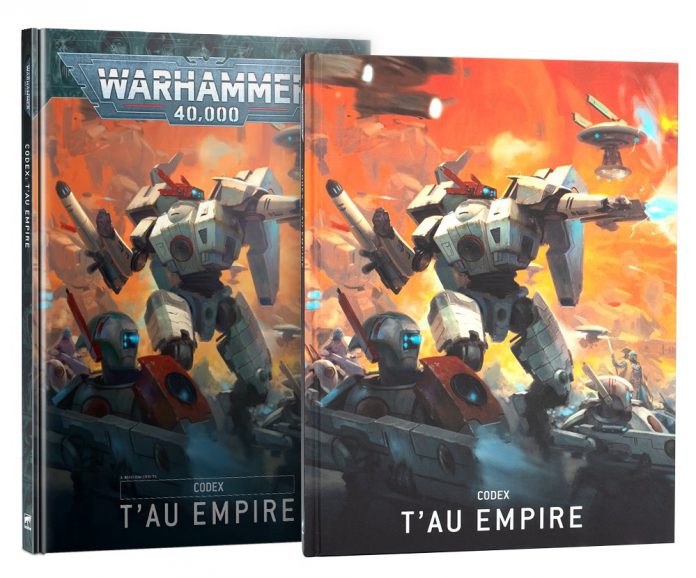Do you like robots? Specifically, do you like anime robots? Do you long for a playstyle featuring high-tech aliens whose armies have developed a method of war just a little more advanced than “shove screaming roided-up teenagers out of a Thunderhawk and pray to the Emperor?”
If so, then the T’au Empire may be for you! After what can only be described as a rough opening 18 months in 9th edition, the new Tau (we’re dropping the apostrophe now) codex has arrived, packed full of guns, guns, guns, and a few other neat things too.
We’re here to talk to you about what’s new with the Tau, courtesy of a review copy provided by Games Workshop. Let’s see what everyone’s favourite bald cow aliens can do!
Why Play Tau?

As implied in our introduction, Tau bring together two archetypes with a lot of appeal – units with an anime sensibility, and a style that is, for want of a better word, more “realistic” than most others in 40k. Nobody’s interested in performing the Sacred Rites of Initiation to power up a piece of barely-understood technology, and nobody is diving into melee swinging a gigantic power fist (well, ok, nearly nobody – we’ll talk about relics later). Instead the Tau fight with powerful, long-ranged guns, utilising graceful anti-grav transports and tanks as well as piloted battlesuits, stuffed full of sleek future tech. In a universe full of Lord of the Rings analogues fighting with swords, they’re powered by science and a rational desire not to be within chopping range of the other creepy weirdos in the galaxy.
Those with memories of 8th edition Tau will probably remember that the promise of the fluff didn’t exactly end up being fulfilled on the table, with competitive Tau being possibly the most obnoxious example of the castled-up gunline approach – take your biggest guns, stick them all in a pile together with as many auras overlapping as possible, and roll dice until your opponent either goes away or manages to kill all your stuff. It was also one of the more limited codexes in that edition, with many of the faction’s iconic units being mediocre to outright bad. The good news is that there’s been some big changes to the faction, and they now play in a way that is much more engaging for both Tau players and their opponents. Tau now play as a dynamic combined-arms force, launching lethal lightning strikes to seize key positions and neutralise the opponent’s biggest threats, then leveraging their formidable defensive tools to secure positions until victory is assured.
What’s in this Book?
- Lore for the forces of the Tau Empire and some of their most notable luminaries
- Rules for constructing a Tau army, including overhauled Sept traits and powerful new versions of the tactical philosophies to reward you for spreading the Tau’va.
- Prototype wargear rules, allowing you to hand out powerful upgraded weaponry and equipment to favoured models.
- Crusade Rules, including rules for carving out your very own slice of the Empire.
- All the stratagems, warlord traits (including for Kroot), relics and secondary objectives you’d expect from a 9th Edition book, plus Invocations of the Elements for Ethereals, who are Chaplains now.
- Datasheets for all Tau Empire units, including auxiliaries like Kroot and Vespid.
The Five Best Things About This Book
- Crisis Teams: Good news Tau players – they rule. Faster, deadlier and tougher and with a whole host of support, Crisis teams should take their rightful place as a core part of Tau armies everywhere.
- Choices: This book is another one where everything looks awesome and you want to try it all out. Deciding what to cut from lists has been hard.
- Guns: From the gigantic rail weaponry that’s been getting everyone hyped up all the way down to the humble pulse rifle, there are a massive number of upgrades to guns in this book, helping every unit with a projectile weapon really pull its weight.
- Mobility: This book understands that Tau need to be able to fight on the move to make up for their lack of melee prowess, and has plenty of tools to help with that.
- Tanks: Yeah you all heard about the Hammerhead, but wait till we get to the Skyray of all things.
Where’s Crusade?
As ever, our narrative review team are hard at work preparing a Crusade review, so make sure you check back in next week to find out how you can build your very own chunk of the Tau Empire.
The Rules
Detachment Rules
As always in 9th Edition, first order of business is to define what a Tau Empire detachment is, along with any restrictions or benefits for building one. Tau armies aren’t super complicated, so most of this isn’t going to be too surprising, but there’s a big new thing here – getting Sept Tenets at all is now tied to your entire army being from the same Sept, not just each individual detachment (with a few carve-outs for Shadowsun, Auxiliaries and the named Ethereals). Given that the new GT pack applies a limitation of one Subfaction to everyone that doesn’t disadvantage Tau much, but there are a couple of cheeky edge cases it shuts down (most notably, because Named Characters are exempt from the GT2022 rule, this stops you taking Longstrike and some Kroot as a side patrol).
Other than that, Tau keep their 8th Edition limitation that each detachment can only contain one COMMANDER, with the exception of Farsight Enclaves, who can have two COMMANDERs per detachment at the cost of not being able to bring Ethereals. Commanders are very good in this book, so that does encourage non-Farsight lists to bring multiple detachments, but Ethereals have some useful tricks too, so both sides of the coin have some attractions.
Army-wide Rules
Philosophies of War
How They Work
As previewed on Warhammer Community, one of the biggest changes in this book is the addition of new rules for the Tau’s two key strategic philosophies – the hyper aggressive killing blow of Mont’ka and the patient counterpunch of Kauyon. Upgraded from once-per game abilities for your Commanders, these are now your army-wide bonus (except for Auxiliaries – sorry Kroot), offering you two different sets of army-wide buffs for part of the game, which you get to choose between after the first turn roll-off.
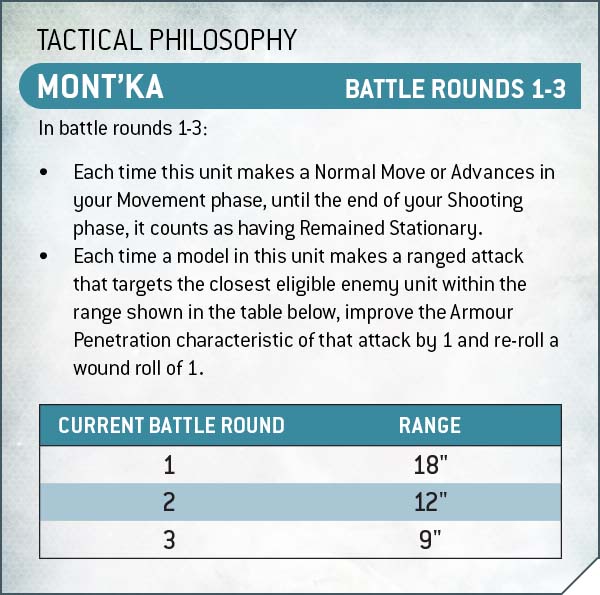
Mont’ka is your option for going fast and breaking things, and offers you benefits to your mobility and damage output for the first three turns of the game. While Mont’ka is active, your units can make Normal Moves or Advance and still count as Remaining Stationary for the purposes of shooting, and when you shoot at the closest enemy unit within a set range (which decreases from 18” to 9” over the three turns) you improve your AP by 1 and get to re-roll wound rolls of 1. This is, obviously, extremely good stuff – Tau have lots of mid-ranged guns that look very spicy in this book, and using Mont’ka allows you to get these into touch fast, and substantially improves their output in the opening phases of the game. It’s particularly useful for heavily mechanised lists, as getting access to re-roll 1s is pretty unusual for non-CORE tanks, and Fire Warriors hopping out of Devilfish (something there’s strong support for – more on that later) are extremely nasty with this up. There’s basically nothing in this book that doesn’t appreciate the extra mobility too – whether it be Crisis Teams launching daring early strikes, or Broadsides sprinting ponderously into firing positions, being able to Advance and Shoot is just always great.
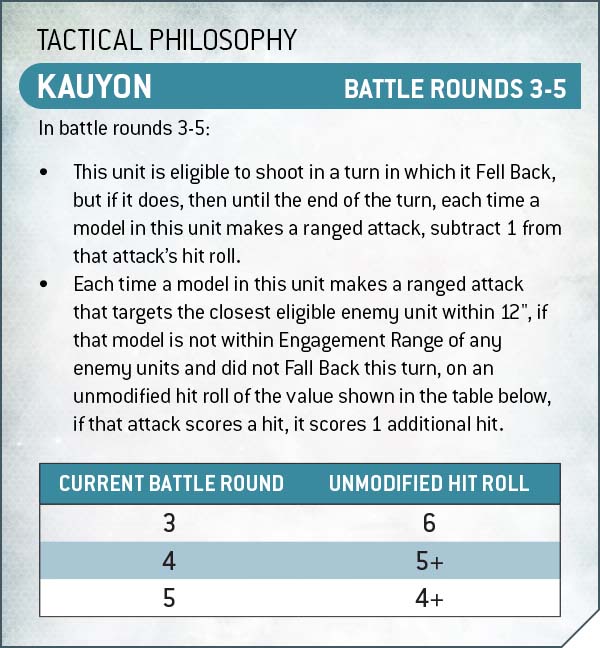
Appropriately, Kauyon rewards generals who want to fight a very different style of battle, one where the enemy comes to them. Kauyon applies to the last three turns of the game, and offers you the army-wise ability to fall back and shoot at a -1 penalty. Alternatively, if your units didn’t need to fall back and shoot at the closest target within 12”, you get extra hits on an unmodified value that improves from 6s on turn three all the way to 4+ on turn five. Kauyon may not give you the initial burst of power that Mont’ka does, but it can provide a powerful defence against a common anti-Tau strategy, which is to take over the board and shut down their guns with continuous bully charges (even more of a threat as For the Greater Good is gone in this book). It also helps against opponents that are relying on melee and close-ranged threats to do their heavy lifting – any Tau list worth its salt is going to have some long distance weaponry to inflict some early damage, and Kauyon helps keep the playing field more level once the opponent starts to fight on their terms in the mid game.
As well as these bonuses, your choice of philosophy ripples out a bit to other things in the book. Notably, there’s a (very powerful) stratagem allowing post-move disembarks from Devilfish that gets better in the turns your philosophy is active, some Secondary Objectives whose conditions change based on the one you choose, and a pair of Warlord Traits that improve if you pick the corresponding Philosophy. That’s a cool little touch, and it’s pretty well balanced – none of the affected things are bad if you’ve picked the “wrong” choice, so it works out as an upside for playing cohesively to your plan – a cool thing to see.
Impact
Wings: This is an unusual new permutation for a 9th Edition army-wide rule, but I’m a pretty big fan of it in principle, as it nails the rare rules sweet spot of being both powerful and mechanically unique in a way that aligns to the fluff. That’s hard to land from a game design point of view, and I think this deserves some praise.
Having said that, I will confess that my heart belongs to Mont’ka, and my expectation is that once players get to grip with the codex, this will be the dominant choice. Mobility wins games, and as well as that the output buff from this is just as impactful on all three of the active turns if you’re willing to go for it, whereas Kauyon doesn’t reach full power until turn five when your army is likely pretty bashed up. I particularly like the impact it has on various flavours of vehicle, plus on Fire Warriors – if the opponent overcommits against a list in Mont’ka, they are going to find themselves absolutely buried under a hail of mid-strength AP-2 firepower before they can really figure out what’s going on.
That’s not to say I would never expect to pick Kauyon – I can imagine lists that want to take it consistently, and paradoxically I think it will sometimes be the correct choice when you end up going first on current tournament tables. If you’re on a board where you can’t see much turn 1, the first turn of Mont’ka isn’t doing much for you, and you probably have the movement to get where you need without it, so perhaps investing in some late game power becomes the correct choice. The fact that I can imagine using both definitely helps sell me on this overall mechanic, but I’ll hand over to Gunum for an exploration of what Kauyon can really do…
Gunum: I needed to talk about Kauyon. I also had to as the only person who saw any kind of usefulness for this army-wide buff. As I was looking at ways to truly benefit from Kauyon I kept realising that the bonus hits, which can be good even if they are a little late in the game, weren’t the focus of this battle tactic. Its the abilities that become unlocked from choosing Kauyon. Exemplar of the Kauyon and the ability unlock of the Devilfish, Tactical Disengagement. The can provide the cagey Tau player with options that the easier to pilot Mont’ka won’t have their hands on.
First off, I wanna talk about Examplar of the Kauyon. As any aspiring Farseer will tell you, being able to redeploy 3 units after you know who is going first can be very game changing. When Wings was talking about Kauyon above and was making it clear that survival is the key to a good Kauyon strategy, minimising the damage you take from Alpha strikes is paramount. If you end up going first, setting up good firing lanes for your Broadsides or moving a Crisis team from a defensive deployment spot to an offense one, can be game changing.
Next, looking a bit closer at Tactical Disengagement we can see ways to push our troop units into that third or even fourth turn. Having a Devilfish or three full of breachers hanging back in your deployment zone to sneak off on turn two, to come into your opponent’s deployment on turn three, and then deliver its incredibly shooty contents allows us to maximise shooting potential, could be a great threat to gunlines around the Warhammer-verse. Playing Kauyon, we’ll want to avoid units that are going to push too hard into the middle. With this in mind, we can focus our army builds around Stealth Teams, Fire Warriors, and Broadsides. Units that want to exist in terrain and live for as long as they can. Our Fire Warriors focusing on using their new long range, and our Broadsides enjoying cover and maximising Smart Missile System targets. SMS targeting units on turns 4 and 5 can help provide intense shooting onto all of the no-mans-land objectives.
Is Kauyon better than Mont’ka? No. I don’t think so. This game can be very punishing early, so you want to maximise those early turns as much as possible. But since choosing between the Philosophies is done after we know who is going first, having an Exemplar of the Kauyon as a secondary warlord, can allow us a unique option to avoid being Alphaed if we are going second. I’m excited to experiment with this in the upcoming book, and I do hope people don’t write it off entirely.
Vrekais: I’m Mont’ka all the way here, I was running Sophisticated Command Nets before and Hardened Warheads and this philosophie embodies both of those benefits, re-rolling 1s to wound and increasing AP but for my whole army rather than just vehicles. Yes the models need to move in such a way to get to the closest target but Mont’ka provides with it’s awesome movement buffs.
Kauyon on the other hand I am struggling with. On paper Turn 5 doubling almost every hit (you might still have a Markerlight for some 3+ hits) is great, but that you don’t get this part of the ability if you fall back or have the enemy within Engagement Range really gives your opponent too much incentive to charge and just weather some Tau melee output.
Battlesuits
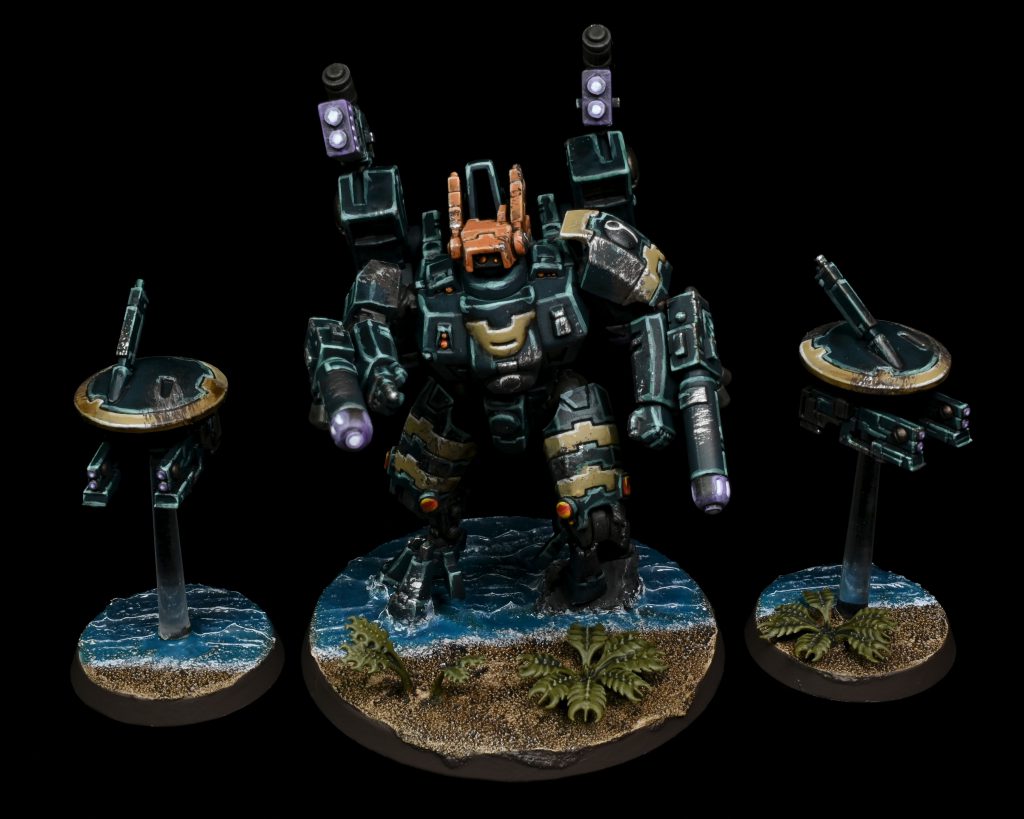
Battlesuits are the iconic Tau unit, and they get a couple of key upgrades in this book. First up, as an actual printed rule, the BATTLESUIT keyword now grants the ability to shoot in engagement range as if you were a Vehicle or Monster. Plenty of the Battlesuits in this book are non-trivial to kill, so this has a pretty good chance of giving you the opportunity to blow away some enemies that didn’t quite get the job done at least every now and then.
Just as impactful, if not more so, is a keyword change – Crisis and Broadside Battlesuits plus all Commanders are now INFANTRY. For Crisis and Commanders that means they can claim Light Cover, a big survivability boost (especially on Enforcer Commanders, who can get pretty eye-wateringly tough now), while for Broadsides it provides the key ability to lurk just behind a wall till it’s time to strike, then burst through and hopefully keep one foot on the terrain’s base to augment their already juicy 2+ save (or alternatively, stand on some battlements blasting away). One other key impact this has on broadsides is that they are no longer limited to the ground floor of ruins or other terrain pieces, now being able to climb to firing positions that befit their heavy support status.
Both of these are very good changes for the army – the former reduces the angles opponents have to completely shut your shooting down, while the latter means Tau now have some of the very nastiest units that can fully utilise the terrain available to them.
Markerlights
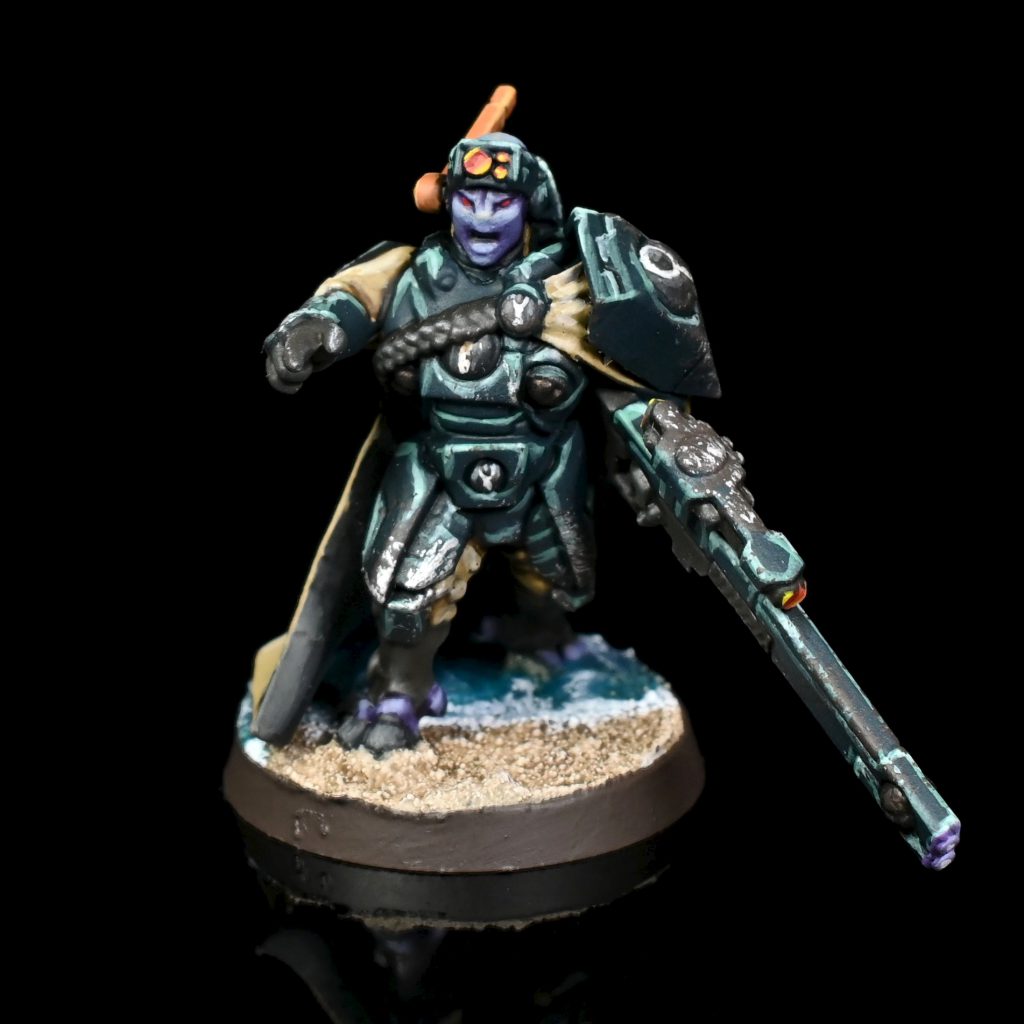
Markerlights get a big overhaul in this edition of the Codex, making use of the Action rules for delivery in a way that brings some upsides, and some downsides.
Fire Markerlights is now an Action that one or more units with the MARKERLIGHT keyword (explicitly including Aircraft) can begin at the start of your movement phase, or the end of your movement phase for Pathfinders. It completes at the start of your shooting phase, at which point you pick an enemy unit within 36” for each Markerlight in the unit (checking target viability as if you were shooting) and roll a d6. For each 3+, you apply a Markerlight token to the target. Then, in the shooting phase, when a non-Auxiliary Tau unit shoots at a unit with a Markerlight token on it, you get +1 to hit, but must remove a token when that unit has completed its attacks (this is non-optional, so make sure you shoot with the stuff you want to get the buff first). In addition to all of this, VEHICLE and DRONE units can move while the Action is ongoing without it failing, but if a mixed unit with some DRONE models and some regular models moves, only the Drones count as equipped with Markerlights for the rest of the turn.
How this breaks down is roughly as follows:
- Regular units that you want to apply Markerlights need to have line of sight to the unit you want them on at the start of your movement phase, so these can be quite tricky to set up. The fact that they always “hit” on a 3+ makes incidental ones more likely to actually do something, but this notably weakens Fireblades.
- Drones and Vehicles are great for applying Markerlights, and it’s one of the reasons that the Skyray looks so strong. You don’t have to select targets till you complete the action, so a Skyray can set up behind a wall, start the Action at the beginning of movement, then pop over to light the foe up. Incidental Marker Drones in a unit look like a way better idea now, as they can apply some target dots on the move, don’t need to worry about their poor BS, and having odd Drone bodies seeded about for Saviour Protocols is something you want anyway.
- Pathfinders absolutely kick ass at throwing down Markerlights because of their combination of lots of them, a pre-game move, and access to Recon Sweep to drop some on the enemy then bug out. If you want to consistently deliver a lot of these, Pathfinders are your guys.
- You’re generally less motivated to try and dump loads of Markerlights on one target – just enough for your alpha units to get the job done, and for those units you get the big payoff right out of the gate.
How many Markerlights you need in a list is something we’re still not totally sure on. There definitely seems to be justification for at least one Pathfinder unit if you want reliability, and getting “free” mobile ones off the Skyray is a no-brainer, but the other dedicated Marker units like Firesight Marksmen have proven pretty tricky to use reliably in our testing, especially on heavier maps like the GW Open tables. Using them effectively also requires some substantial discipline in your shooting phase, as it’s easy to accidentally fire some small arms or side weaponry at a unit you’ve teed up a counter on and boom – gone. Finally, the Farsight Enclaves can get by with far fewer Markerlights than everyone else thanks to their Sept Tenet, which we’ll get to in a bit, and not having to try and pack these into lists has definitely felt like a pretty considerable upside. This is undeniably a very powerful mechanic, but both at list construction and on the table it’s going to need experimentation and finesse to maximise.
Drones
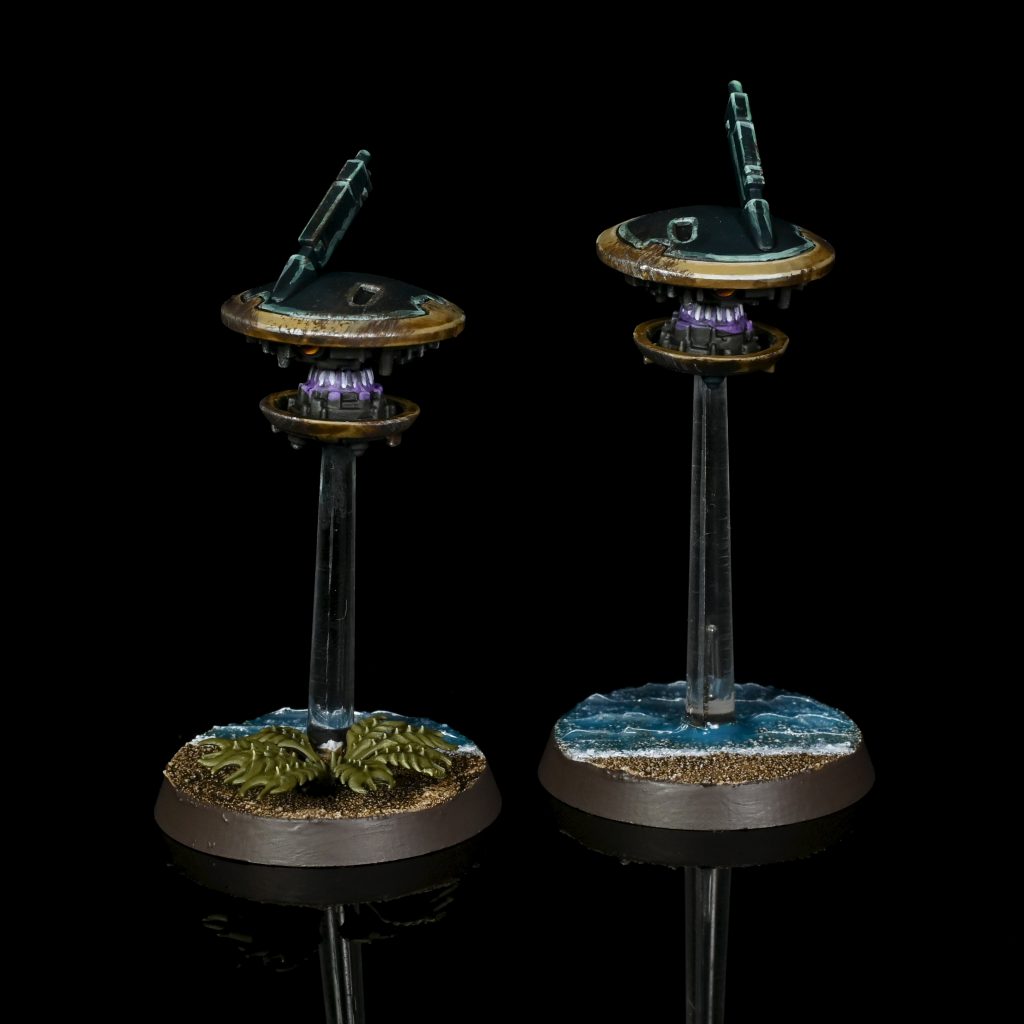
Drones are another staple of Tau armies, and for anyone with nightmare flashbacks about some of the Shield Drone castles of 8th Edition there’s good news – Drones are back as unit add-ons now. Many units are either equipped with Drones to start with, or can buy them as extra wargear, and when they do this adds the Drone models to the unit (except for Vehicles, which work a little differently), operating as part of the squad but with some special rules.
They don’t change the unit’s toughness, are completely ignored for the purposes of the Look Out Sir rule (so do note that units that only add up to three models because of Drones can’t protect Characters), don’t count for morale when they die and don’t gain the unit’s keywords. You might be wondering why the last one matters, and it’s because Drones aren’t CORE, and a lot of rules in this book are worded to account for that, providing bonuses to “CORE models in a unit” rather than a “CORE unit”. While that also means they aren’t INFANTRY when attached to squads, they have a special rule to allow them to count as such “for the purposes of interacting with terrain features”, which definitely lets them traverse them where relevant, and we assume also allows them to gain Light Cover (which is very nice). It also means that Drones in units with a character are not CHARACTER themselves meaning they don’t count for secondaries such as assassinate. There are some circumstances where Drones can become separated from their units, and if a unit is only Drones then they cannot perform any Actions other than firing Markerlights, and lose Objective Secured if they somehow have it.
At baseline, this now means that Drones protect units the old fashioned way – if you have one in the squad you can allocate a successful wound to it and watch it get blown into tiny pieces (or maybe bounce it on a shield drone invulnerable save if you’re feeling spicy) but Saviour Protocols as a general rule is gone. It does, however, return as a stratagem, which for 1CP can allow you to sacrifice a nearby Drone to reduce the damage of an attack to 0 after failing a save. This doesn’t have to be from the same unit the attack hit and can apply to anything, so if you’re in a railgun shootout with another Tau army having some Drones about is super handy (though you still suffer any other consequences like Mortal Wounds).
Drones on Vehicles work a little differently, because at baseline they are essentially just guns for the majority of purposes – they start “docked” to the vehicle, it counts as having all their guns, and they don’t count as a model on the battlefield for any purposes. You can, however, set the Drones free using the Designated Tasking Stratagem, splitting them off into their own unit. That’s the only way to liberate them though – on the death of the vehicle, the drones are consumed too. This feels a little weird as a rule because 90% of the time the drones are just going to work as guns – but the drone option is generally priced with this in mind, so you aren’t really paying for the small additional flexibility you’ll occasionally get.
Most units can take the standard choices of Shield, Marker and Gun Drones, providing access to a couple of wounds with a 4+ invuln, a Markerlight or some extra shots respectively (and not too pricey) but there’s also a whole range of weird and wonderful special Drones that various units get, which we’ll largely cover as we look at the Datasheets. Adding random gun drones doesn’t look super relevant most of the time, with the possible exception of going all-out on a Crisis Team, but incidental Shield and Marker Drones come at a good rate, and having a few kicking around is just useful.
You can also buy squads of Drones, and we think there might be some play for this in Farsight Enclaves – you need some Drone Controllers seeded around the board to get their BS to a good level, but you can pack an eye-watering number of pulse shots into a unit for not very many points, which might prove effective.
We do feel that the rules here feel a bit overwhelming on a first readthrough, but once you’ve got a handle on what’s up this should make Drones a much more seamless part of Tau lists going forward, and definitely one that’s worth having.
Manta Strike
Your bog-standard deep strike option, with a few abilities keying off using it. Next.
Ambushing Predators
All Kroot, not just Carnivores, now get to make a 7” pre-game move. This remains useful on basic Kroot for screening (suddenly significantly more relevant again with Genestealer Cults packing a decent book), and may now give you an angle to punish a careless opponent with a Kroot Hound bully charge every now and then.
Ethereals
Ethereals are now priests (though without the keyword for some reason), getting a Chaplain-style list of Invocations they can use, which we’ll cover further down. In addition, they all get the Inspired to Greatness ability, which lets them designate a nearby CORE or AUXILIARY unit to be able to Shoot while Actioning, a very good fit for the new GT missions, can share around their impressive Leadership stat, and for the two Named ones can be brought in an army from any non-Farsight Sept. All good stuff, and there’s definitely some use cases for them.
Subfactions
Tau get six named subfactions to choose from, all with a Sept Tenet, Warlord Trait, Stratagem and Relic as you’d expect. They also get another new spin on custom Septs, picking two abilities from curated lists based on the map of Tau galactic dominion. There are some notable standout Septs this time around, but all of them have at least something interesting going on, so let’s take a look.
Tau Sept
The original orange Tau – accept no substitutes. Tau Sept start strong as one of this book’s recipients of a “one re-roll” trait, with each of their units getting to re-roll a hit or a wound each time they shoot or fight. This trait almost always ends up as one of the better options available and it’s no different here – there are plenty of strong guns in this book with a small number of hyper-lethal shots, the perfect match for this ability. In addition, Tau Sept units get boosted aura sizes, and a matching boost to the range of Command Phase effects. This is a bit more niche, but does end up with Shadowsun having a truly spectacularly huge re-roll aura, as her Drones also boost the range of these. On that note, one of the unwritten upsides of Tau Sept is that they have access to more Named Characters than anyone else – Shadowsun and Aun’va can go in any list, but get better in Tau, while Longstrike is very good, and Tau only.
Moving on from the tenet, Tau also have an extremely strong stratagem in Focused Fire, which after an enemy model loses a wound to a shooting attack lets you give CORE units +1 to wound them for the rest of the phase. Broadsides and Crisis suits are both lethal CORE shooting threats, and even the humble Fire Warrior can end up very spicy in this book, so this is just extremely good, with the only mild downside being that whatever you’re teeing it up with is going to eat a Markerlight token.
The Warlord Trait and Relic here both provide some defensive herohammer tricks, with the trait providing a 5+ ignore wounds effect, and the Vectored Manoeuvering Thruster Relic being a bit more spicy – speeding you up and letting you move when the enemy tries to charge you (albeit they do get to select new targets). The queue for spicy commander upgrades is pretty long, so it’s unclear if either of these get there, but the relic feels like it has some possible applications (and hilarious doesn’t actually have to go on a commander, so if you want a Fireblade with rocket boots, knock yourself out we guess).
The tenet, stratagem and access to Longstrike are all good enough that this Sept has a very high chance of seeing play – it’s just very effective for building an all-rounder list.
Vior’la
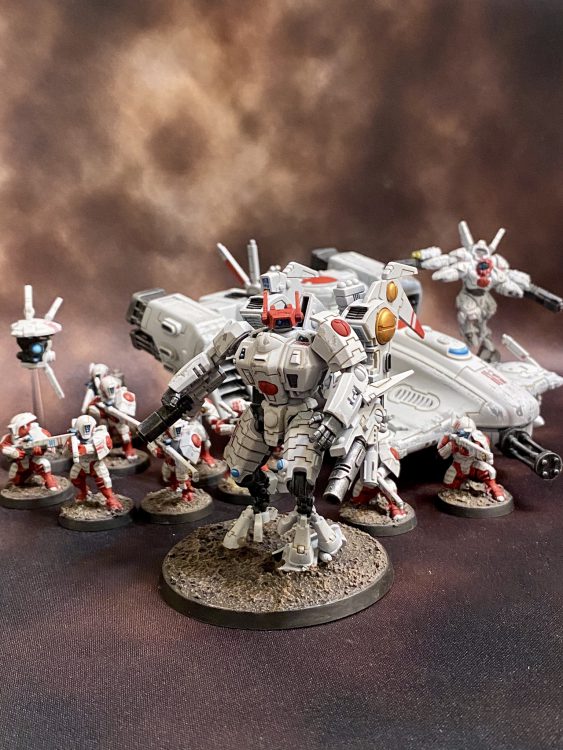
Viorla is the first of two Septs that wants to go very fast, and sadly probably comes out behind Farsight for that role. Their Sept Tenet allows re-rolling of Advances and Charges and has a very unusual second part that gives all their units +2” movement on the first turn, letting them launch rapid strikes early game. This is certainly OK, but honestly suffers from the fact that the general level of support for aggressive movement in this book is really good – you don’t need these buffs.
Their warlord trait is OK, providing access to CP regen (though in this Sept you’re probably just tapping up Aun’shi for that, as we’ll see) and the relic provides a pseudo-smite in a faction that doesn’t have many such effects, but really the biggest draw here is the stratagem, Hot-Blooded, which is your standard “mortals on 6s to wound” up to a cap of 6. That’s a strong effect wherever it shows up, but here it’s 2CP and has to target the closest enemy unit, making it harder to use than you’d really like. It is still strong, and unusually it doesn’t have a CORE rider so you can use it on a pretty broad range of stuff, but it’s not enough by itself to lift this faction up – you just don’t need enough of what it’s bringing to pick it over the other options here.
Sa’cea
Sa’cea are The Sneaky Ones, another time honoured subfaction archetype, and get a pretty standard trait for that – they count as in Dense Cover outside either 12” (INFANTRY) or 18” (VEHICLE, which now includes bigger battlesuits, no more MONSTER in this book), and if the opponent does manage to get in their face they’re excellent at point-blank volleys, with their VEHICLEs and BATTLESUITs not taking the -1 penalty for shooting heavy into combat. The value of this style of trait fluctuates wildly, but it’s plausibly OK in this faction, as they can throw down a lot of hulls and expect to get some actual significant resilience from it early game. It’s likely to struggle to compete with Tau or Farsight simply because what Tau need help with is reliably clearing people off objectives rather than a boost in a long-ranged slugfest, but it’s at least meaningful.
The rest of the package here is good too – all three other tools are things you’ll utilise. The Strategic Warlord Trait lets you hand out ObSec to one friendly unit in your command phase with only a SEPT keyword restriction, so if you have ever dreamed of an ObSec Riptide, here it is. The Relic is a Fight Last for all engaged enemies plus a penalty to hit rolls on incoming melee attacks, which is maybe a bit better than you’d expect because a Commander can be built to be surprisingly dangerous in a fight without absolutely needing a relic slot to do it. Finally, the Orbital Uplink stratagem is a definite “boring but effective”, allowing you to pay 1CP so that your units ignore the benefits of cover against an enemy unit for a phase. Bypassing Dense Cover is a huge deal for Tau, so this will be gold when that comes up, and sometimes cracking Light Cover can be a big deal as well.
Sa’cea ends up pretty middle of the road overall – you’re going to feel like it’s doing good stuff for you, and if it’s your favourite Sept you’re going to have a great time in narrative play, but it’s probably not quite where the top competitive builds will come from.
Dal’yth
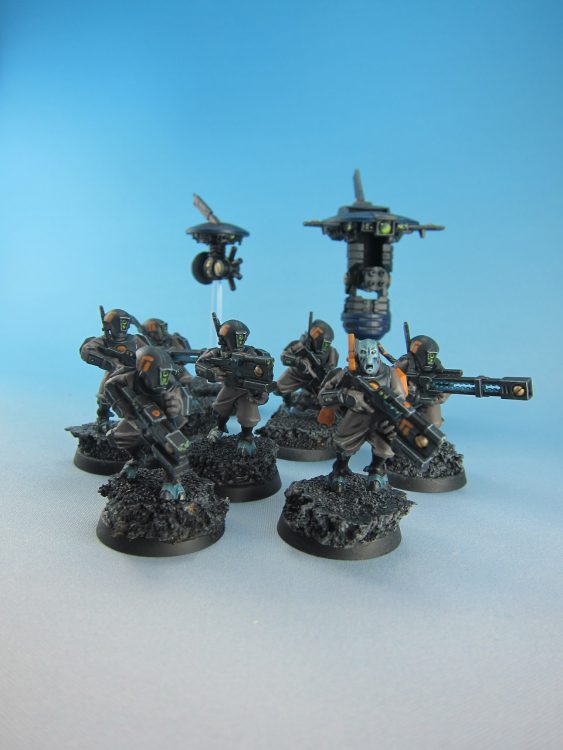
Dal’yth are also The Sneaky Ones, but with a slightly different flavour based on their integration of highly advanced Auxiliary tech. Their trait provides INFANTRY units with Light Cover against anything except shooting in combat, and also allows Auxiliaries to benefit from Kau’yon or Mont’ka. Jumping ahead to their Warlord trait, this also allows Auxiliaries to benefit from Markerlights, and the combination of Markers and Mont’ka looks like it could be extremely potent applied to Vespid in particular.
The Relic and Stratagem are both also pretty good. The relic essentially turns a Commander into a Ghostkeel, only allowing them to be shot if the attacker is within 12” or they’re the closest target, and supplying a 5+ invulnerable save to boot, ideal for a Commander who just wants to stand at a distance with 2x missile pods and 2x plasma rifles and blast away for days. Finally, the Stratagem lets either a CORE or Auxiliary unit dive into strategic reserves if they’re within 9” of a battlefield edge at the end of your Movement phase.
This feels like there could be a genuinely spicy theme list lurking somewhere within it. Light Cover (almost) all the time is extremely good on Crisis Suits and Broadsides, and even your basic Fire Warriors aren’t going to complain in the slightest about rocking an effective 3+ save. Add in the fact that Dalyth Vespid hit like trucks if you drop them in on turn 2 and it feels plausible that someone contrives a build that really makes this sing and it’s another one that will definitely feel good in Narrative play if this is how your guys are painted. Green and purple is a strong look.
Bork’an
If you play Tau it seems pretty likely that you’re a Battlesuit appeciator, and Bor’kan have some toys to offer you. Their Sept Tenet does two separate things – boosts weapon ranges by 4” for everyone (which is especially great on Breachers where it ups the reach on their big shots), and provides a protective effect for Battlesuits and Vehicles, reducing the strength of incoming ranged attacks by 1 if the starting strength was 7 or less. This can, obviously, vary wildly in how useful it is. The biggest issue it has is that if the opponent turns up with all melta weaponry (as many do right now) it doesn’t do anything and you look a bit silly, but there’s quite a bit of S5 shooting around that bounces off Crisis teams nicely with this. Realistically, this probably did need to work on S8 stuff to be properly worth it, but it’s something that could shift a lot if the metagame changes.
Next on the fancy toys list are some Commander upgrades, allowing you to boost the AP of their guns and add some mortals on 6s with the Seeker of Perfection trait and boost the wound rolls of two of their guns (as long as you’re within half range) via the Overdrive Power Systems Relic. Both of these look very usable – the trait is behind the generic Precision of the Hunter option for a murder Commander, but some lists absolutely want two, so go wild, while the relic can slot onto pretty much any build nicely thanks to the increased range.
Really, truly though, if you’re coming to Borkan it’s to do something silly with the Stratagem, Experimental Weaponry. This allows you to pick a gun on one of your units and just flat ignore invulnerable saves with it for a phase, which is very, very funny. Nothing else in the book is going to quite compare to dropping this on the Stormsurge’s pulse blastcannon and just unleashing hell, but it’s also situationally excellent on a Skyray’s missiles, the Riptide’s big Ion and a Heavy Rail Rifle.
For Bork’an to properly break out competitively we probably do need to be in a world with a few less meltaguns, but as with a lot of these it’s going to feel fun to use.
Farsight Enclaves
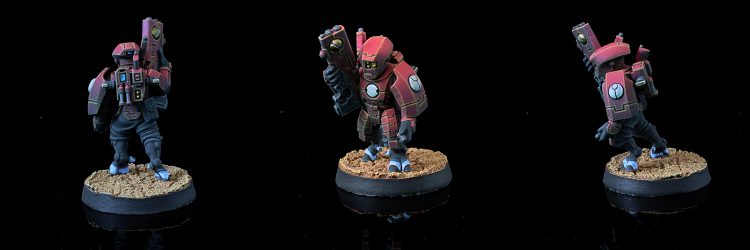
The Farsight Enclaves get what is very likely the best sept tenet in the book, which is that they always count the opponent as having a Markerlight when attacking within 12”, and get one wound re-roll per unit when they attack. This is an extreme output boost if you’re willing to play aggressively, and (appropriately) combines very well with Mont’ka. More than any other option in the book, this really helps Tau with the thing they need the most support in – cleanly dispatching the enemy up close.
They’re also helped here by two things – the fact that Farsight is in this faction (surprise) and the stratagem. Farsight we’ll cover in Datasheets, but he’s definitely worth having in lists, and the stratagem is a super-powerful buff for Crisis Suits or Commanders arriving from either Manta Strike or a Homing Beacon – just flat full hit and wound re-rolls. It ain’t cheap (2 or 3CP depending on unit size) but it’s a direct upgrade of a vanilla Stratagem (which only provides hit re-rolls) and looks like it can be used in combination with cunningly crafted 3-model Crisis teams to throw out an atrocious amount of pain for a modest investment.
The Talisman of Arthas Moloch is also handy, providing the army’s only access to a Deny (and at +1 to boot), and while the Warlord trait is probably a bit of a miss even that may actually have occasional play in the current metagame – it boosts a Commander’s AP on 6s to wound, which is kind of whatever, but also allows them to ignore effects that ignore wounds, so if you just want to barbecue a bunch of Wracks with flamers and burst cannons, go wild. It’s also there in the back pocket as a tech choice if C’tan ever become a huge part of the metagame, as they’re something Tau tend to struggle with and this lets you just mow one down.
The fact that this trait really rewards aggression and lets you boost up Vehicles and Drones much more easily than many other Septs can combine to make this look like one of the most promising choices here. If I (Wings) were a betting man I’d say it’s between Farsight and Tau Sept to create the first big breakout build here, and I’d lean maybe 60:40 towards the red ones.
Custom Septs
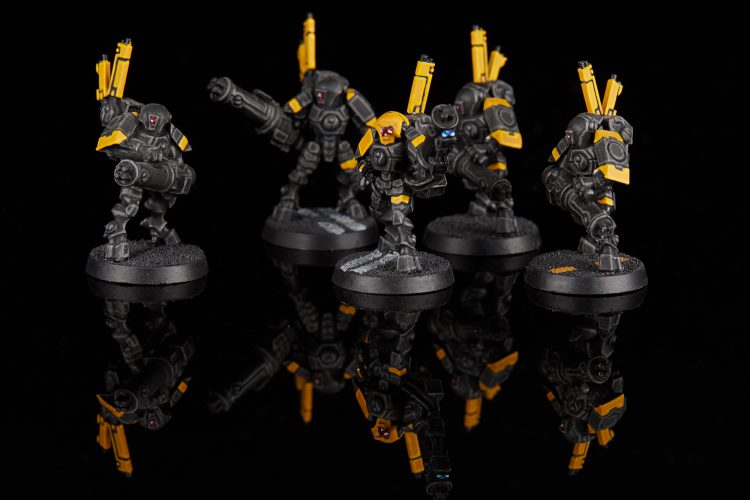
At this point it wouldn’t be a new Codex without a new spin on Custom Subfactions, and Tau are no exception, getting to pick the standard two abilities for a Sept Tenet, but with slightly more complicated curation mechanics than normal. Essentially, you are presented with a map of the Tau Empire, and have to pick one trait each from two neighboring sectors out of five, each of which has four trait choices.
Sector A sits square in the middle, so can be paired with any of the others, and the other available pairs are sectors B &C or D & E. Even with that limitation there’s a formidable array of combinations here, plus the standard option to inherit abilities from one of the named Septs, here called Allied World, so are any of them any good?
Not massively if we’re honest. There are some cool abilities on this list, some named after returning favourites from the Greater Good, but the best main Septs are very strong and a lot of the upgrades you used to pull from Custom Septs have been baked into weaponry now. Most notably on that front, all missile weapons in this book are just flat 1AP better than they used to be, and Hardened Warheads is now just Ignore Cover, which is much less exciting and you get part of one smart missile systems for free.
In terms of the stuff here you might want to try out, the good news is that quite a bit of it is in Sector A, giving you flexibility to combine it as you choose. If you want mobility, Strike Swiftly gives your INFANTRY a 6” pre-game move, which is well known as a strong effect (even if this is a weaker version than Relentlessly Expansionist), while for attacking objectives you’ve got Play Their Part, which lets your battlesuits count as extra models for controlling them. If you just want to shoot stuff (which I imagine most Tau players will relate to) then Calm Under Pressure is pretty good, boosting your Assault weaponry’s strength when attacking within 12”.
For each of these, there’s certainly stuff you can effectively pair it with. Evasion Maneuvers from Sector C lets you double down on a mobile, aggressive playstyle, giving all your FLY units a 5+ invulnerable save when they Advance. Combining this with a bunch of hulls and Calm Under Pressure could give you a list that’s very scary in Mont’ka, as historically anything that lets you get invulnerable saves onto lots of tanks has generally proven pretty strong. For more of an objective-focused plan, Sector B Blocking Tactics gives your CORE INFANTRY ObSec whenever they charge (or double counts if they already had it), which includes Crisis Teams and can let them play for the primary very effectively, especially if you take Play Their Part as well.
Finally, Sector D has a couple of generically useful traits in Reliable Weaponry (one Wound re-roll) and Reinforced Armour (the Borkan strength modification defence), both of which could pair up well with the good ones from Sector A if you have the right units in your list. Unfortunately Sector E doesn’t really offer any additional goodness to combine with them, containing one OK trait, two mediocre ones, and then Enriched Reactors, which might be the single worst faction trait that has been published in a codex all edition – it provides a “buff” that only applies to plasma rifles, and makes them worse into almost all targets.
Surprisingly, the most relevant thing in this whole section might be a curveball from the Allied World option, which Vre’kais and Gunum have cooked up between them. Choosing to inherit the abilities of Farsight Enclaves gives you access to their (extremely powerful) Tenet, Warlord Trait and Stratagem, but doesn’t bring the detachment building rules along with it – meaning you can have an Ethereal. This may genuinely be something you want to do for a Crisis-heavy list, as dropping Sense of Stone on them while farming CP is extremely useful. Gunum has, naturally, named this the “Outer Enclaves”, and you can see his planned list later on in the article.
Gunum:“Outer Enclaves? Wings. Why do you let him do this to you all?” Okay, look. I understand, I hear you… but… Hear Me Out, what if… you could take all the benefits from Farsight Enclaves, and still get the utility of the Ethereals?
“Gunum. You can’t just throw Outer in the front of you weird builds and expect it to be awesome. The Dark Angel fans almost threw you out of their rocky-clubhouse for that.” Which is a very fair point, dear reader, but from atop my weird blue fish-goat horse of righteousness, I can proudly tell you that I don’t care. I like it and it sounds cool.
It’s also functional! With all the test games I’ve been able to explore, I’ve found Farsight Enclaves to be amazing. I play them currently in 8th, and this new alliteration of them is nearly the best of the Scepts I’ve been able to try. The primary cause of this success is from the massive utility provided by not needing that many markerlights. Self-sustaining support! My lists have been averaging 3 ~ 4 total marker lights and I sometimes feel like that’s too many. With that in mind, along with a deep need to find a way to keep my mecha sons safe, I started to hunt for ways to make those forward forces a bit more durable, and my eyes couldn’t escape the new Sense of Stone, which gives a core unit a 5++. I needed that for my six man Crisis suit unit, so the exploration began.
As Wings pointed out, taking the Allied worlds option allows it to be Farsight Enclaves-lite. We lose access to two commanders, Farsight himself, and the Deny the Witch artefact. But we -gain- Ethereals. From a lore standpoint, we can pretend this is some kind of Heretic/Renegade Ethereal, which the idea of seems super cool to me. From a gameplay standpoint, suddenly we get all of the aggressive, offensive, forward push feel of the FSE, but we can actually support those elite units and help protect them from Mortal wounds and multi-weapon damage. I’m being hauled off to explain myself and the list better… I’ll be back…
Vrekais: As a custom sept fan the new system is a bit clunky, I definitely get the impression the map idea was had first, and then something to use it second. With regard to combinations though Calm Under Pressure seems incredibly strong for a Montka force, a lot of the new rules are encouraging or helping Tau get in close for a devastating blast. Combined with Reinforced Armour my Stealth and Gunship focuses lists get a decent boost in both damage and resilience. It almost makes Carbines on Fire Warriors tempting as an option between Rifles and Blasters. Letting them get to S6 AP-1 with Calm and Montka, or AP-2 with the Relentless Fusillade stratagem. The Accelerators Bursts can trivally become S7 letting them pose a threat to most light vehicles, even with 1 Damage; 16 S7 AP-2 shots with re-roll 1s (after Montka buffs) is a lot. Really happy for those Burst Cannons to finally have a reason over Gun Drones or SMS that they’ve struggled to compete with in the past. Stealth suits were already a great harassment unit but reducing attack strength by 1 really does make them tricky to remove from cover, making even the usually dependable S4 wound them on 5+ and S3 wound them on 6+!.
Stratagems
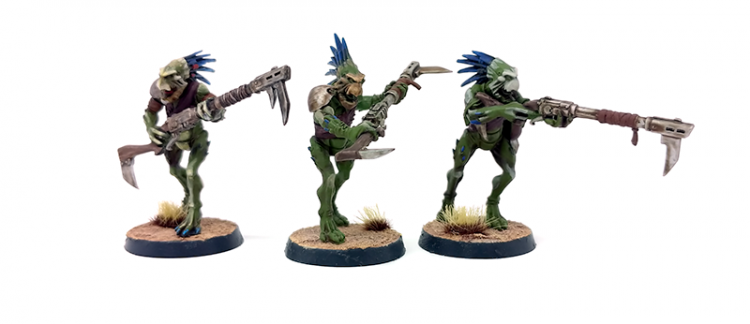
The Stratagem sheet in the new Tau Codex is one of the most sweeping refreshes we’ve seen this edition, up there with Genestealer Cults, at least in part because a lot of their core mechanics have changed. A small number of old favourites have functionally returned (almost universally improved), with Breach and Clear still providing juicy wound re-rolls for Breachers, but now just ignoring Light Cover rather than requiring the opponent to have it, A Trap Well Laid (an update of Ambushing Predators) letting Kroot do a 6” heroic and get +1A, Point-Blank Volley being the closest to completely unchanged (allowing Fire Warriors to shoot in combat), and Fail-Safe Detonator has been massively levelled up, now doing more damage more often, especially from bigger suits. Back Up AI is a new twist on the previous books Simulant Injectors, letting any Tau Empire model count as having full wounds for determining characteristics, a massive improvement on the preview Battlesuit only version as it now helps gunships keep going!
Beyond that though, we’re into new ground, even if some of the names are the same. Let’s cover some revamped ones first. Branched Nova Charge is updated to support the new way Riptide reactors work, letting you shrug off a failure from it rather than pick new abilities, which is definitely useful, while if sneaky Battlesuits are your thing then Wall of Mirrors is great, letting Ghostkeels or Stealth Suits dive off a battlefield edge to come back on next turn – always useful, and strong with the Aerospace Targeting Relays secondary. Recon Sweep also becomes a hugely important part of powering your Pathfinder teams, allowing them to boost their rolls to land Markerlights and make a Normal Move after completing that action, letting them light the enemy up and return to safety (including into a Devilfish, if that is your boat that floats). Finally on this front, Repulsor Impact Field rules now, letting you apply a -2” penalty when your opponent tries to charge a Battlesuit unit, ideal for protecting yourself from deep strike chargers, and given that it applies for the whole phase once activated it can also lessen the blow from a multi-charge that your opponent has painstakingly prepared.
Our next category is Stratagems that replace old mechanics or interact with the way equipment is handled now, such as Counterfire Defence System, allowing a model with the relevant suit system to reduce the damage of an incoming shooting attack to 1 for 1CP. You do have to use it before rolling a save, but there are certainly circumstances where slamming that button is going to feel very worth it, and trying to sneak one of these into a Crisis Squad (or onto a free wargear slot on a Riptide or Stormsurge) feels worthwhile. If you do end up with a failed save against a big attack you can also just blow Saviour Protocols, allowing you to sacrifice a Drone within 3” to reduce the damage to 0. You do still suffer any other consequences of the attack (e.g. Mortal Wounds) but having these two effects available in combination is very potent, as it can badly punish opponents who are trying to operate off a small number of highly reliable big damage weapons (e.g. salvo launchers, heat lances). Still on Drones, if you long for them to be free to frolic independently across the battlefield you can free them from either a squad or being docked on a Vehicle using Designated Tasking, probably not something that comes up that often, but maybe worthwhile if you want to leave Drones behind while a tank goes on a glory charge. Submunitions for Hammerheads was shown off on Warcom and yeah, it rules into big squads, and is going to live rent free in Necron players minds for a while, but Skyrays also get a fancy toy, with Frequency Lock letting them fire their missile racks at +1 to wound, and also enables targeting something out of LoS if you’ve managed to get a Markerlight on them. Technically any model with a seeker or destroyer missile can use this, so it’s occasionally going to be worth it for the Stormsurge as well, who can fire two per turn . Finally here, Ethereals get access to the standard “automatic prayer” stratagem – which here is most likely to be used to immediately drop Sense of Stone onto a Manta Striking Crisis Team, as it can be done in any phase.
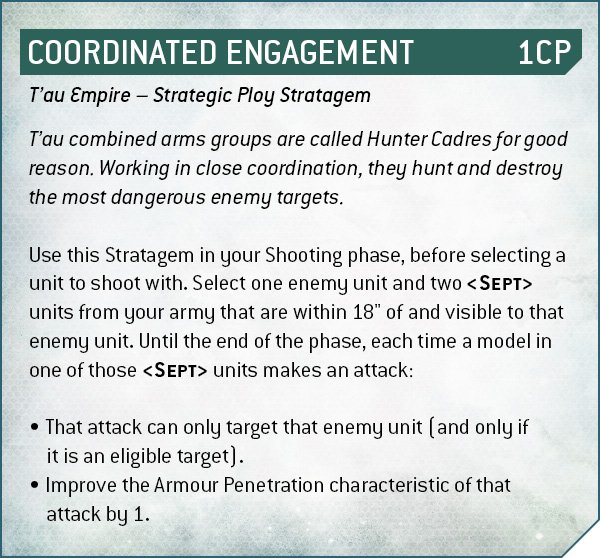
That leaves us with two big themes remaining – buffing Crisis Teams, and turning the Fire Warrior/Devilfish partnership into a super powerful one. Helping out on both fronts is Coordinated Engagement, letting you pick two units that have to fully target the same nearby enemy unit, but get +1AP for doing so – ideal if you’ve built a more dakka-based Crisis Team and want to tag team them with a Devilfish to do some big damage. Crisis Teams also get the ability to Strike and Fade, moving after shooting at the cost of being able to charge, and while this clearly rules it is critical to remember that this has to be done at the start of the shooting phase, because if you come to it late in the phase you’re going to have rolled a lot of dice and potentially burned through marker tokens, meaning even the most generous opponent might be left struggling to work out how to rewind and let you do it. Riptides and Commanders can also use this if needed. Also on the mobility kick here, Dynamic Offensive lets Crisis Suits auto-advance 6” and ignore the penalty for Advancing and Shooting, which since that’s pretty much all their guns is hugely useful in a pinch, especially if an Enforcer Commander has handed them ObSec. Last of all, while it’s not as awesome as Farsight’s version, any Sept can hand hit re-rolls to a Crisis team coming out of Deep Strike with Drop Threat Acquisition, which you’ll probably want to blow when it comes up.
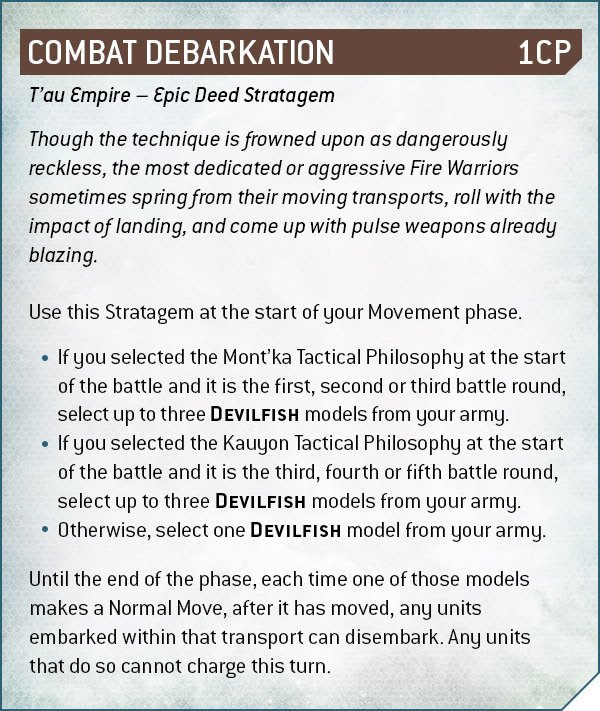
To close then, the mighty Devilfish. It looks like someone was pining for the Fish of Fury era, because these things are incredible now. They’ve got some good tricks on their datasheet, but what really brings them to the fore is Combat Debarkation, allowing you to disembark units after moving with a Devilfish – or with up to three if you use it on one of the correct turns for your chosen Combat Philosophy. Disembark after move is always good, and this is fantastic for setting up Breachers in particular, especially in combination with On-Board Sensors, which can provide a hit RR1 aura for Fire Warriors from a Devilfish against a specific target. Even if you’re not using this to get straight into the opponent’s face you can get some value here – Strike Teams get access to Relentless Fusillade, letting them Rapid Fire at full range and handing them an extra point of AP. It’s worth highlighting that there are a lot of ways of boosting up Fire Warrior AP pretty easily here, which is going to make them a nightmare for elite infantry without an invulnerable save – just combining this with Mont’ka gets you as far as AP-3, and adding Coordinated Engagement is an easy-ish path to -4, quite something.
You get the standard extra relic and warlord trait upgrades too, of course, and the overall picture here seems really, really good – there’s good effects here that support attack, defence and mobility, most are competitively priced, and some standouts really make a few units sing. Great stuff.
Warlord Traits
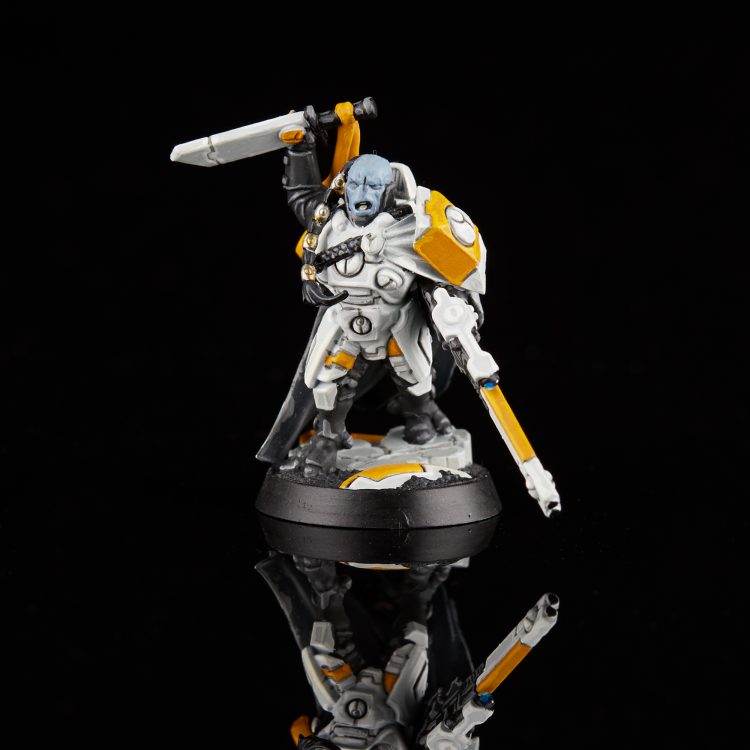
As well as those for the factions as outlined above, there’s six generic Warlord traits in here. The names will be familiar from 8th edition, but the effects are universally way better. A good example here is Precision of the Hunter – previously, your Warlord got re-rolls of 1s to wound against VEHICLE and MONSTER units, not exactly a huge upgrade all considered. Now, it gives your character full hit and wound re-rolls, in both melee and shooting – a huge upgrade in their effectiveness, especially since Tau characters can take real guns. Combining this with the Onager Gauntlet from the Relics section also gives you a powerful melee punch, something which isn’t always a feature of Tau armies but becomes genuinely attractive here.
Probably the least changed – and most commonly seen in the past – trait is Through Unity, Devastation, which now applies to CORE only and relies on unmodified 6s to wound for its effect, but now works on any enemy unit instead of requiring you to pick one. It also now works in Overwatch, though that’s less impactful than it might have been in the past.
Something which might pull you towards the Kauyon philosophy rather than the strong arguments for Mont’ka above is Exemplar of the Kauyon, which is the now-common trait allowing you to redeploy units, including putting them into Strategic Reserves – just one ordinarily, but up to three if you picked Kauyon for your philosophy. Then again, Exemplar of the Mont’ka lets you pick a CORE unit within 9”, and give them re-roll wounds with ranged attacks against an enemy unit within 9” of them, buffed to 12” if you picked Mont’ka as your philosophy, lethal if you’re up close.
Gunum: These are two traits I expect to see in 98% of the lists I build. With how Mont’ka and Kauyon are implemented in this new codex, having the option to benefit from either of these at a moments notice is utility I won’t leave at home. There are going to be games when we want to put on our best Eldar impression and hide the three Devilfish that we deployed a tiny bit aggressively. There’s games were we are going first and want to reroll every wound ever and take maximum advantage of Mont’ka. Really excellent warlord traits that I’m thrilled are in the book. I guess Precision of the Hunter rocks too.
Rounding things out are A Ghost Walks Among Us – which keeps the old auto-advance 6” ability but also makes your character -1 to hit – and Through Boldness, Victory, a targeted effect that gives one CORE unit auto-wounds on a 6 to hit with ranged attacks.
It’s a strong set of traits, with some interesting choices to make. Precision of the Hunter is your obvious port of call for making a Commander into an individual powerhouse, but Exemplar of the Kauyon grants priceless redeploy capabilities, while Exemplar of the Mont’ka, Through Unity, Devastation and Through Boldness, Victory all offer useful buffs that help amp up the capabilities of your key units.
We shouldn’t forget about the Kroot, of course. The birdmen get three traits of their own, each one granting a different aura; Master of the Hunt lets nearby Kroot ignore the benefits of cover with their shooting attacks, Pack Leader lets them roll 3D6 and discard a dice for charges, and Nomadic Hunter lets them count as having Remained Stationary for the purposes of ranged attacks so long as they didn’t fall back. How much you want these depends on how much you want Kroot, but for the purposes you’re likely to put them to, a Shaper with Pack Leader or Nomadic Hunter isn’t the worst thing you could do in this book.
Relics
Twelve relics here, a mix of returning favourites and new kit. These are now “Relics” too, rather than Signature Systems, in line with the drive to standardisation (which is good).
Of these, we’ve already mentioned the Onager Gauntlet, which is now hilarious – it’s basically a free melee weapon for a BATTLESUIT model, granting a mighty S12 AP4 profile with damage 3. That is a profile that is genuinely dangerous, especially combined with Precision of the Hunter. An excellent upgrade.
Speaking of upgrades, the Multi-Sensory Discouragement Array was previously one of the most worthless relics in the game, giving enemy units within 6” -1 Leadership. Now it’s picked up the cool utility features we’ve seen in a couple of other places, like the Psychomancer – you can pick an enemy unit within 12” at the end of your Movement phase and roll 3D6 against their Leadership, and if you beat it then you choose to either remove Objective Secured from them, halve their Move characteristic and charge rolls, or force them to only target the closest eligible unit with ranged attacks. That’s a lot of useful utility, though you are of course at the mercy of the 3D6.
Further interesting effects include the Advanced EM Scrambler, giving an Omniscramblers-style 12” bubble preventing enemy deep strikes, and also the ability to pick a nearby enemy unit in your Command phase and prevent them from being affected by aura abilities except ones that are psychic powers. Which makes sense; electromagnetic waves don’t do anything to wizards. The Puretide Engram Chip also returns and grants a mighty 3+ to refund Command Points spent on a Stratagem, but only if it’s a Battle Tactic or Epic Deed – something to bear in mind playing both with and against Tau.
There’s some good clean fun in here for Ethereals, with The Humble Stave offering a Master of Sanctity-style buff to know an extra invocation and get +1 to the roll, or the Neuro-Empathic Nullifier which can cause an enemy unit to fail an action on a 2+, or prevent them starting a new one – particularly powerful in the new Nachmund missions, where a significant proportion of the bonus primary objectives are action-based.
Ka’chak’tarr is a neat upgraded Kroot rifle for a Shaper which you probably won’t ever actually want, though the Borthrod Gland might have utility if you’ve gone Kroot-heavy, with a once per game effect which grants nearby Kroot +1 Strength and Attacks.
Rounding out the section here are the Solid Image Projection Unit, a neat combination of a 4+ invulnerable save and a once per turn “reduce Damage to 0” effect, Ohr’tu’s Lantern which buffs your markerlight rolls, and The Kindled Blade, which seems to exist just to give Fireblades something unique to take and which you will probably not ever want.
Finally, there’s The Be’gel Hunter’s Plate (I truly cannot tell if the pun here is meant to be “bagel hunter” – does anyone know if there’s a good bagel place near Warhammer World?), handing out a neat +1 to saving throws and a 5+ to ignore wounds. Need a guy to live a little longer? Then give him this, and he will. An Enforcer Commander with this is incredibly tough, starting from an effective 1+ save with damage reduction and a feel no pain, meaning they can tangle with almost anything and come out alive.
Prototype Systems
Perhaps unsurprisingly, Prototype Systems are now Tau’s paid upgrade option, letting you take additional wargear or super-powered versions of weapons on Commanders, Crisis Team/Bodyguard Sergeants and Ghostkeels (though there’s really only a few for the latter). Most are weapon upgrades (where like relics you have to buy the base weapon first) but there are a couple of bits of more esoteric fare here too. Same deal as ever with these – only one per unit, only one of each, none for Named Characters.
Weapon wise, we have to admit that there’s a general trend of these maybe being a little bit too pricey, though that’s not universal. The ones that are likely to stand out here are the cheapest and most unique – the Advanced Burst Cannon and the Thermoneutronic Projector respectively. The Advanced Burst Cannon is just a much better burst cannon for only 15pts extra, adding shots, strength AP and the ability to prevent the opponent ignoring wounds from it. If you’ve been following competitive play recently you’ll know that Wracks are one of the game’s defining units, and this can be helpful for chewing through them, especially if you’ve got re-rolls from somewhere. The Thermoneutronic Projector is spicy because it gives a Commander a meaningful melee attack. It’s a super flamer with extra AP and damage (though oddly doesn’t auto-hit, but outside of Overwatch that doesn’t super matter), and the Commander can also use it in melee. Whenever they fight they can make d6+2 extra attacks at its S4 AP-2 D2 profile, and there’s nothing stopping you using it with the rest of their attacks too. This is great with Precision of the Hunter, as 9 or 10 average attacks at that profile with full hit and wound re-rolls is an extremely real melee profile, and one you don’t need to use your relic slot for, letting you stack a defensive tool like the Be’gel Hunter’s Plate.
Elsewhere in the way of the gun, there’s an upgrade each for missile pods, fusion blasters, plasma rifles and airbursting frag all of which sound cool but are tricky to justify the points for. The Resonator Warheads has the most powerful effect, halving the speed of INFANTRY/CAVALRY/BEAST units it hits, but it’s a hefty 30pts, so we’ll see if it turns out to be worth it. It’s possible that the Dominator Fragmentation Launcher, which applies a massive -4 Ld debuff to things it hits, could see some use, as that’s the kind of swing where applying this then killing a Talos gives your opponent a coin flip to lose another, potentially extremely funny.
Moving onto weirder stuff, we have a return for the “old” version of Early Warning Override in Wide-Spectrum Scanner, which is cool but requires you to install that support system and is going to be a “known” thing your opponent can play around, which may make it hard to justify. More easily used are some tools for dropping mortals, either when you fly over the enemy or (for a Coldstar) when you move to or from a location with either Internal Grenade Racks or Starflare Ignition System. The Ghostkeel’s E-H Disruption Suite gives them an intensely annoying once-per-game aura to punish opponents going big on stratagems (ironically excellent in the Tau mirror) while Sensory Negation Countermeasures gives a once-per-game debuff you can apply to an opponent attacking you in melee – which given how tough Crisis now are, might sometimes be enough to save them.

Last and definitely not least are Stimm Injectors, which feel quite likely to be one of the most used here. These run you only 10pts, and can be activated once per game when the bearer loses a wound, giving them a 4+ to ignore wounds for the rest of the turn. This is cheap enough that you should be stapling it to the sergeant of your biggest Crisis unit pretty much every game, as it can be stacked with Iridium armour and judicious use of drones, Counterfire Defence System and Saviour Protocols to create some serious ablative resilience on what’s likely one of your most valuable units. If you aren’t using it for that and have a Commander who doesn’t have a prototype system already, slap this on – you basically cannot go wrong at the price.
These will definitely get used, overall, but the majority of the weapons could probably have rocked in at 5pts cheaper and been a bit more appealing. We would expect the Thermoneutronic Projector and Stimm Injectors to be the biggest hits.
Invocations of the Ethereals
In place of their old elemental auras, Ethereals now get six Invocations to choose from that they can activate in your Command Phase. Basic Ethereals know two and can activate one on a roll of 3+, but both Named Characters know three and can chant two on rolls of 2+, and adding the Humble Stave to a basic Ethereal gets you the double chant and 2+ rolls. The investment to get to the better version is minimal either way, and if you’re making space for an Ethereal in your list you will almost always want to – especially because two of these really stand out.
These are Strength of Stone, handing a 5+ ignore wound roll to a CORE unit (absolutely something you want for your Crisis or Broadside team), and Wisdom of the Guides, which just flat gives you a CP when you activate it. Both of these are exceptional effects, and you’re basically happy having an Ethereal on permanent double duty between these at the price you pay for one.
If you’ve got a named Ethereal you will get a third selection too, of course, which probably ends up being Zephyr’s Grace, allowing you to give a CORE unit -1 to hit against Ranged Attacks as long as they don’t stay still. Obviously if you’re doing a big alpha play with your Crisis team you can double this up with Strength of Stone for extra heft, which is why it’s probably the most relevant to have in your back pocket. Power of Tides could also be useful in specific lists, as it lets you give Auxiliaries a +1 to wound boost – potentially making a Kroot counter-charge surprisingly deadly, or making inbound Vespid spicy (if you apply this using Wisdom of the Many) in some sort of Dalyth theme list.
The other two probably won’t do much. Storm of Fire lets a unit Action while shooting, a good effect but one that every Ethereal just gets one free use of at baseline, so not something you need more of, while Unifying Mantra is a morale aura that’s similarly not going to be needed much when an Ethereal is already there, as anything in range to benefit is also in range to get Ld10.
Ultimately, these pay off for you – it’s very likely that you’re only ever going to want to bring one Ethereal, and there are enough good choices here to fill out that Ethereal’s slots and have them add serious value. Good stuff.
Secondary Objectives
Three secondaries on offer for Tau here, and they’re… interesting. Aerospace Targeting Relays is a Shadow Operations objective which requires you to place an Aerospace Designation marker halfway along each battlefield edge, and lets your INFANTRY units do an action at the end of the Movement phase which completes at the start of your next Command phase or the end of the battle. Like similar objectives, your goal here is to scan each point once, and you get a scaling number of VPs depending on how many you achieve – a paltry 2 if you only manage one, all the way up to the maximum 15 for hitting all 4.
Worth noting here is that a) the action can be done by one or more units, so you can absolutely hit multiple points at once, and b) Crisis and Broadside suits are now INFANTRY (as are many of your CHARACTERs). That gives this surprising utility; at a minimum you can expect to hit the objective on your own board edge, and scoring the two side ones for 9 points isn’t likely to be that hard. The stuff that is likely to be going towards the enemy also has decent options on being able to fly over and grab the farthest point in the late game, and of course you can do multiple at once and kick it off on turn 5 and still score. It’s not necessarily easy to score, but it could well prove to be an easy 9 in many games with surprisingly strong chances of managing the full 15 – though of course it’s in a category with Raise the Banners High and Retrieve Nachmund Data.
Over in Battlefield Supremacy we have Decisive Action, which scores you 4 VPs per turn if you hold half or more of the objectives at either the end of your turn in battle rounds one, two, and three (if you picked Mont’ka) or three, four, and five if you picked Kauyon. The idea here is interesting, but also you’re capped at 12 and your opponent has a specific window where they can focus on trying to shut you out of scoring it before it stops scoring at all. You can fulfil the same conditions with Stranglehold and while you won’t ramp up quite as quickly, you’re not restricted to 12 VP and you’re not losing so much at once if you do miss a turn. The flipside is that this is slightly easier than Stranglehold for an army short on melee threats (unlike Stranglehold you still score this if both you and the opponent hold three), and means you only have to push for big objective plays on three turns. This probably drops down to eight enough of the time that it doesn’t quite get there, but it’s maybe better than it looks on a first read.
Finally there’s A Clean Victory in No Mercy, No Respite, similarly splitting its scoring requirements between Mont’ka and Kauyon with the same windows (so rounds 1, 2, 3 for the former or 3, 4, 5 for the latter). You pick up 1VP if a single enemy unit was destroyed in that battle round, and a further 3VP if three or more enemy units were. There’s a minor but interesting tension here with the philosophies – Mont’ka lets you have a go when you have the maximum of your units on the table to try, but you’re also open to being completely shut out on turn 1 by a cautious opponent, especially if you go first. Meanwhile Kauyon means you’re likely to be in the thick of things by the time it kicks in, but there’s a reasonable possibility that there won’t be enough stuff left in round 5 to maximise the scoring. A bit like Decisive Action, you have a lot of failure points where you can be left with a very average score for having picked this; when it works it will work out well, but there’s going to be games with this where you miss a little and get brutally punished for it, which doesn’t exactly recommend it as a choice.
The Units
Equipment
Tau share a lot of their guns between multiple units, and also have suit support systems seen across many different battlesuits, so rather than talking about them every time they come up, it’s probably easiest to have a general chat about them first.
Guns
Tau weaponry has seen pretty significant boosts, with plenty of weapons gaining range, shots AP or some other bonus, and a few getting more fundamental re-imaginings. The key ones are:
- All missile weapons gain a point of AP, essentially baking Hardened Warheads into their basic profiles. Seeker missiles also hit at S9 for 2d3 damage now, and no longer need Markerlights to function – hefty stuff.
- All burst cannons are better, with INFANTRY ones getting more shots, and the ones on bigger tanks getting uplifted to be accelerator burst cannons, which have an extremely spicy 8 shots at S6 AP-1.
- The plasma rifle gets a re-work, and boy what a re-work – it’s a single shot, but it’s 30” range, S8 AP-4 D3, an enormously powerful profile, and very effective when paired up with missile pods for longer ranged Crisis teams.
- Only the Hammerhead railgun gets to ignore invulns, but all flavours of rail weaponry hit hard and do automatic mortals as soon as they wound, helping push through defences.
There are plenty of other more individual upgrades too, which we’ll look at with the units.
The other shared detail about guns is how costs work for weapons on battlesuits. This book clearly wants to encourage mixed loadouts, as you pay more for duplicate guns, with each weapon having three prices – one for the first time you pick them, one for the second and one for if you’re taking the third or more. These tend to go up in increments of 5pts, but a few (mostly the ones that got spammed in 8th) jump further, usually seeding in a 10pt jump somewhere.
The outcome of this is that as a starting point, you rarely want to take more than two of the same gun, and almost never want to duplicate beyond a 10pt jump. While the guns all do somewhat different things, at the point you’re hitting a ten point hike for one there’s usually a different choice that will give you a more efficient solution to the same problem. Plasma rifles also stand out massively because the first one is only 5pts on Crisis teams, making the first a very cheap way to add a strong shot to a model. Commanders are where you may still, sometimes, want to specialise a bit more, but expect to see Crisis going with a varied diet of death most of the time. It does also have the side effect for Crisis teams that there isn’t as much incentive to try and build a “cheap” unit any more – you can’t just stack up burst cannons, keep them cheap and rely on buffs. You can get a 45pt model down with a plasma rifle, airburst and burst cannon, but when it’s only 5pts more to turn one of those into a fancier gun, there’s little incentive not to.
The positive spin on this is, of course, that as long as you’re willing to take three different guns you get spicier Crisis suits way cheaper than you did before – a battlesuit with a CIB, missile pod and plasma rifle only runs you 55pts compared to 66pts in the old book, and is massively better in every way!
Gunum: You’re going to see very quickly how this was a great idea from Games Workshop’s point of view, but at the same time, could be a very terrifying idea for new players to this kind of book. I am a man who loves endless options, and the way these battle suits are being presented to us, by spreading out weapons amongst different suits in a unit, provides deep options for players like myself. What we will see from “good/reasonable players” is something along the lines of min-maxed suits, across a six Crisis-suits unit. You will see the same suit, six times in a row, along with some drones to defend those boys. What this does is provide the player and their opponent with an easy-to-understand unit, where It is easy to follow along with what they are doing, as well as easy to track what guns you lose when models get killed. Then, you’re going to have players like me, who want to have customized suits that match different needs. In a squad of six suits, you might have: An anti-tank guy, an anti-infantry guy, and an anti-horde guy. Suddenly, you’re playing a game with your very own version of the eight. This, from a paperwork standpoint, can get very confusing. If you are going to go this way, which is a direction that I think GW is kind of forcing the public into, you will need to find a way to keep track of all your different guns on your unit. As you will see soon, I take a direction that might be a bit extreme with these guys, but at the same time, I feel that my crisis suits are providing the utility I need for the job that I want them to do. That job is to bully the middle of the table and get me those objectives! I am incredibly happy that GW took this direction, because the way that crisis suits has always been sold to me, was as a very individualistic option in the Tau. Where each suit is designed with the preferences of its pilot in mind, and now we’re able to reflect that on the tabletop.
Vrekais: As an old soul Tau player I think that a lot of the reasoning for not mixing weapons has been removed over the last few editions. Before 8th a model needed a Target Lock to be able to shoot at a different target to the rest of its unit, so you would pick guns that were either the same or would be efficient at shooting the same things. 8th threw that concern out of the window but didn’t really give us the right set of profiles to mix. We had some 18” guns, one 24” gun, one 36” gun. None of them were reliable enough to always be splitting fire. The new profiles however have changed that, Plasma and Missile with their range and characteristics now complement each other greatly, and because they don’t have to account for spam with their cost now so the first one can be relatively cheap of each. Fusion and Burst can be taken as reliable weapons in their own right to be shot at two different targets. It was far too easy to reach 70 or even 80+ points for a Crisis suit before this codex, especially when weapons needed to also be costed with Crisis Commander’s BS2+ in mind. Whilst the new system is a bit awkward for listing at first, in my opinion it’s a massive improvement.
Support Systems
The other thing you attach to battlesuits is support systems, providing various buffs and special abilities. Many of these have been overhauled, and the majority are now free. In some cases you pay an opportunity cost of using up a weapon slot but that’s honestly not that common – basic Crisis Teams now get a freebie support system slot on top of their weapon hardpoints, and bigger suits get free slots for these, meaning it’s only really Commanders and Crisis Bodyguards who have to drop guns for them. There are some restrictions on who can take some of these, with the most notable being that Broadsides can’t take Shield Generators any more, so watch out for that.
There’s a lot of these, so it’s honestly easiest to just blast through them:
- Shield Generators give you a 4+ invulnerable save. You do pay 5pts for this, but you should still assume you’re stapling these to the support slot on most of your on-table Crisis models – that is an aggressive price.
- Target Locks let you ignore Light Cover. This can be good for a Crisis Team planning to drop in and use one of the re-roll strats with airbursts and CIBs.
- Velocity Trackers retain their ability to give +1 to hit against FLY targets. Could be great if Craftworlds are the next hotness.
- Multi-Trackers give exploding 6s against big units. Being real, this is not something Tau need help with.
- Counterfire Defence Systems allow you to use the relevant stratagem – good to have in the back pocket.
- Early Warning Overrides let you overwatch at a cost of 0CP with the unit, and the bearer hit on 5s when doing so. Pretty scary on a Riptide.
- Commanders get a new Positional Relay option, which allows you to set up a Strategic Reserves unit in a position as if it were one turn later once per battle round, as long as they’re near the Commander. Not hugely sure what to make of this one – as worded, it only seems to affect where on the board the model can come in rather than allowing you to bring a unit on turn one (which would be very good in combination with Exemplar of Kauyon), but if so it’s then very niche. Definitely one that’s going to spawn some enthusiastic discourse until an FAQ.
- Drone Controllers are now for Ghostkeels, Stealth Suits and Stormsurges only, and allow you to buff up Drones in your command phase.
Broadsides get some additional options (including the Advanced Targeting System, which is only for them now) which we’ll look at in their entry.
In general, it feels like your Crisis teams mostly want shields with a few specialising, Commanders probably want to use a relic pick for defences as much as possible so they can focus on killing power, and your big suits probably want a Counterfire, Early Warning Override and your choice of whichever offensive tool you think helps most.
HQ
Tau have broadly three categories of HQs, Commanders, Ethereals and Markerlight Guys, with Longstrike sitting off to one side as a special option for Tau Sept and Kroot Shapers doing their own thing. Each of these categories has at least one Named Character in them, so for each we’ll go through the basic flavours then cover the special ones.
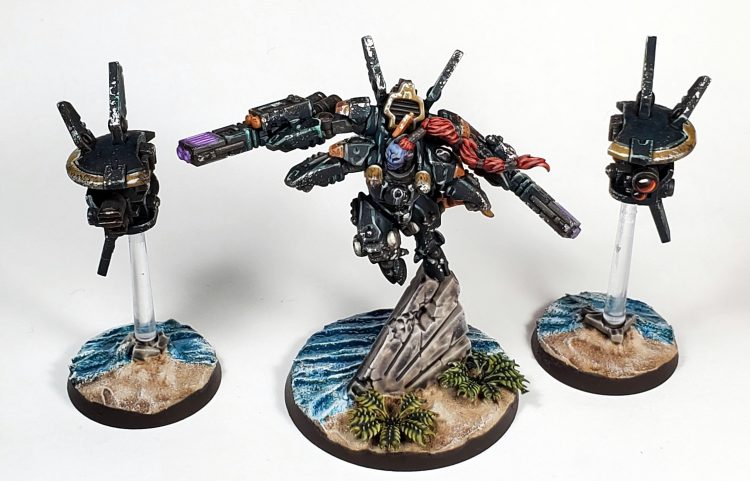
Commanders are a mixture of damage dealing and buffing. With Mont’ka and Kauyon moved off to army rules and Markerlights simplified, the Master of War aura on Commanders is now your source of re-roll 1s for CORE, an extremely welcome update. Each commander can also become a formidable damage dealer, packing four hardpoints for guns or wargear, and thanks to defensive relics like the Be’gel Hunter’s Plate and Solid Image Projection Field (which don’t take slots) you can often afford to take four guns here, dealing tonnes of damage with BS2+.
Commanders also come in three flavours – Crisis, Enforcer and Coldstar. This provides them both with some on-board special abilities and a different buff each that can be applied to CRISIS CORE units in your command phase. This is a really cool touch, giving you a reason to include each beyond just maximising your damage. Crisis Commanders are kind of your “basic” commander, with their only notable feature being able to upgrade to a 2+ save with an Iridium Battlesuit, but bring the extremely useful ability to allow a Crisis team to Fall Back, Shoot and Charge and also ignore any negative hit roll modifiers. This is great for keeping them operating in a fight, and Crisis Commanders are also the cheapest, meaning they can be a good inclusion.
Enforcer Commanders are thicc. Not only do they get an extra wound over Crisis Commanders, they start on a 2+ save as baseline and have damage reduction against incoming attacks. Their buff is also great, giving a Crisis Team ObSec, hugely powerful for making a big play. An Enforcer Commander loaded up with the Be’gel Plate, Precision of the Hunter and one of the two melee options is a genuinely excellent brawler, something Tau are otherwise sorely lacking, making them extremely useful.
Coldstars, finally, are your fast Commanders, with a better basic move, once per game re-deploy and the ability to allow Crisis Teams to auto-Advance 8”. The latter is a bit meh – you already have an option to auto-Advance Crisis 6” via a stratagem, and that comes with ignoring hit penalties too. However, having access to extreme speed on the Commander themselves is extremely useful in a pinch.
Ultimately all three basic Commander options have some appeal – the Enforcer maybe stands out because they can do something that very little else in the army manages, but all could fit into builds. All of them can also bring a few drones from the standard gun/marker/shield choice if you want.
Those aren’t your only choices here, of course, with Shadowsun and Farsight both being available as named alternatives (and both have to be your warlord if you take them, or one of them does if you take both). Farsight is the easier one to cover – he rules. He’s a souped up Crisis Commander with their (very helpful) buff, an actual melee profile from the Dawn Blade (now with a sweep option), a super plasma rifle and a minor melee buff for a nearby CORE unit. Being real – he’s 5pts more than a Crisis Commander with two plasma rifles and a shield generator, so if you’re running Enclaves, just take him.
Gunum: Do it. Do it. He rocks real hard.
Shadowsun is more of a divergence from regular Commanders, but she seems pretty good. She’s a Supreme Commander, and can be taken alongside any Sept, and this time around all her auras etc. properly respect that. Because of the Commander limit, her being in a separate detachment is extremely useful, and she slots into lists very easily. She also brings the (essentially) standard Chapter Master ability, able to give one CORE or CHARACTER unit full hit re-rolls in your Command Phase. Her aura also covers a massive amount of space, as her Command-link Drone and Tau Sept both extend them, taking her to an impressive 12” re-roll 1s bubble, which is pretty handy. She’s also no slouch herself, packing both some enhanced fusion blasters (each either longer ranged or lower damage but two shots) and a light missile pod for some additional damage. The high-energy fusion blaster option seems best here, as in the current metagame full of damage reduction you want the big hits, and they also pair well with Tau Sept re-rolls. Finally, she’s pretty hard to take down – you can’t target her unit at all unless she’s the closest eligible target thanks to her Advanced Guardian Drone, and she’s at -1 to hit and packs an built-in invuln. She’s slightly pricier than Farsight at 150pts, but brings a lot of things to the table for that.

Next up, Ethereals. Your basic Ethereal is very cheap at only 60pts, and can go fast by flying around on a hover drone for only 5pts more. They bring Invocations, a leadership aura and the ability to grant one unit Action + Shoot to the table, and are fine for covering your likely needs for Strength of Stone and Wisdom of the Guides here if you give them the Humble Stave. If you can spare a few points more, however, or can’t spare the relic pick, both Aun’va and Aun’shi are extremely good, and both can be taken with any Sept (though only get Tenets if they’re wih the correct one). They rock in at 80pts and 85pts respectively, and for that you get boosted Invocations built in, boosted defences and a substantially improved number of D2 attacks such that they’re not totally harmless in melee. Of the two Aun’va seems a little better – he’s much harder to kill, as all inbound attacks have -1 to wound, and the opponents have to chew through the Ethereal Guards first, so you can’t just lose him to one unlucky big hit. However, both also have a unique ability and Aun’shi’s is a little more impactful – it only works in Vior’la, but for them he lets units Set to Defend or Hold Steady in the open. It feels like Aun’va should be in a lot of lists because of how useful he is, but both of these are good picks and are in many ways interchangeable.
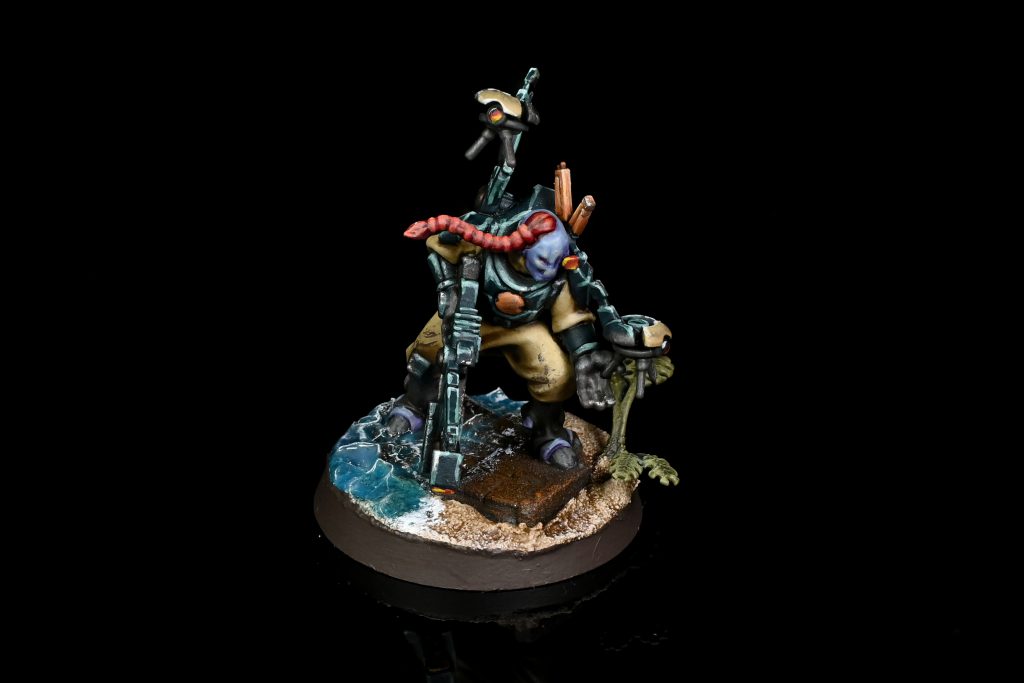
Your Markerlight Guys are the Cadre Fireblade and Darkstrider. Cadre Fireblades are, to be honest, a lot more skippable than they used to be. They do still have a very good aura for Fire Warriors in Volley Fire, granting extra hits on 6s, a potent effect because of how dangerous their guns are. They can also grant one unit RR1s to hit in your Command Phase, and pack a Markerlight – none of which is bad, but doesn’t align super well with how the army is likely to play. You are either likely to have Fire Warriors leaping out of Devilfish and going to town or operating from your firebase, at which point they’re usually in a Commander aura anyway. These are super cheap at only 50pts, and do get an improved pulse rifle (a nice touch) but you definitely don’t need one.
Darkstrider, on the other hand, kind of rules, being a much more synergetic user of Markerlights. Like Pathfinders he can deploy his after moving, and also packs a Structural Analyser, allowing him to choose a visible enemy unit in your command phase, and give a nearby CORE unit +1 to wound against it. Normally abilities like this can be hard to line up, but because he gets a pre-game move it’s far easier to set this up against a key target early on, and that helps get his markerlight into position too. Finally, his gun is pretty good, he gets extra re-rolls, and he gives non-Battlesuit CORE units (so essentially Fire Warriors and Pathfinders) the ability to fall back and shoot. He does a lot for his 60pts, and is an appealing choice in Tau Sept armies.
Also an extremely appealing choice for Tau Sept is Longstrike, a souped up Hammerhead Gunship that sits in an HQ slot. For a paltry 15pts premium over a regular one you get better BS, an extra hit re-roll, boosted wound rolls against monsters and vehicles and the extremely good XV02 Pilot Battlesuit ability, allowing you to grant a CORE or Hammerhead unit nearby the ability to always count as having a Markerlight. This is super good because, honestly, what you really want from Hammerheads is their threat potential – keep them lurking behind terrain where the opponent can’t get them, with the full promise of popping out and annihilating their favourite toys if they commit. Between handing out a free markerlight and his SMSs being able to do better chip damage to high value targets while he’s hiding, plus extreme reliability on the turn he commits, Longstrike plays this role massively better than average, and is exceptionally good overall. With the +1 to wound, he may also be the one Hammerhead where you could seriously consider the ion cannon over the railgun, but that’s another thing where the current damage reduction metagame messes with the maths a lot – so probably just stick to the cheaper, scarier railgun. Oh, also, right now he can be Bodyguarded by a minimal Crisis Bodyguard team hiding behind a wall. If you enjoy having zero (0) friends then knock yourself out with that for the next four weeks.
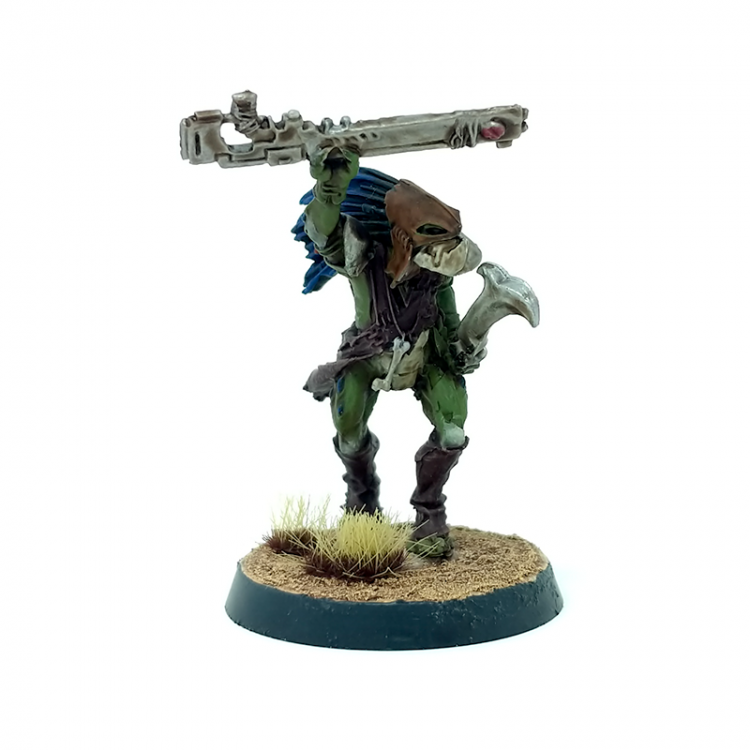
Finally in HQs, Kroot Shapers. They lead Kroot. That’s kind of it – they’re pretty mediocre stat-wise, but they’re incredibly cheap (a mere 25pts) and help out Kroot enough with a RR1 aura that if you find yourself with some points left over, you could bring one. Aerospace Relays allowing Characters to do it helps make them a bit more appealing too – like all Kroot they get a pre-game move, so you can swing them over to a mid-table relay position very easily out of the gate, even from relative safety. The last thing to say here is that there’s a new wargear option for a grenade bandolier that’s presumably intended to represent Dahyak Grekh now that the BSF datasheets have been retired. RIP to a real one.
Realistically, every Tau list you build is going to have at least one Commander, often two, and you can fill to taste from the rest of the options here – there’s plenty of decent stuff.
Troops
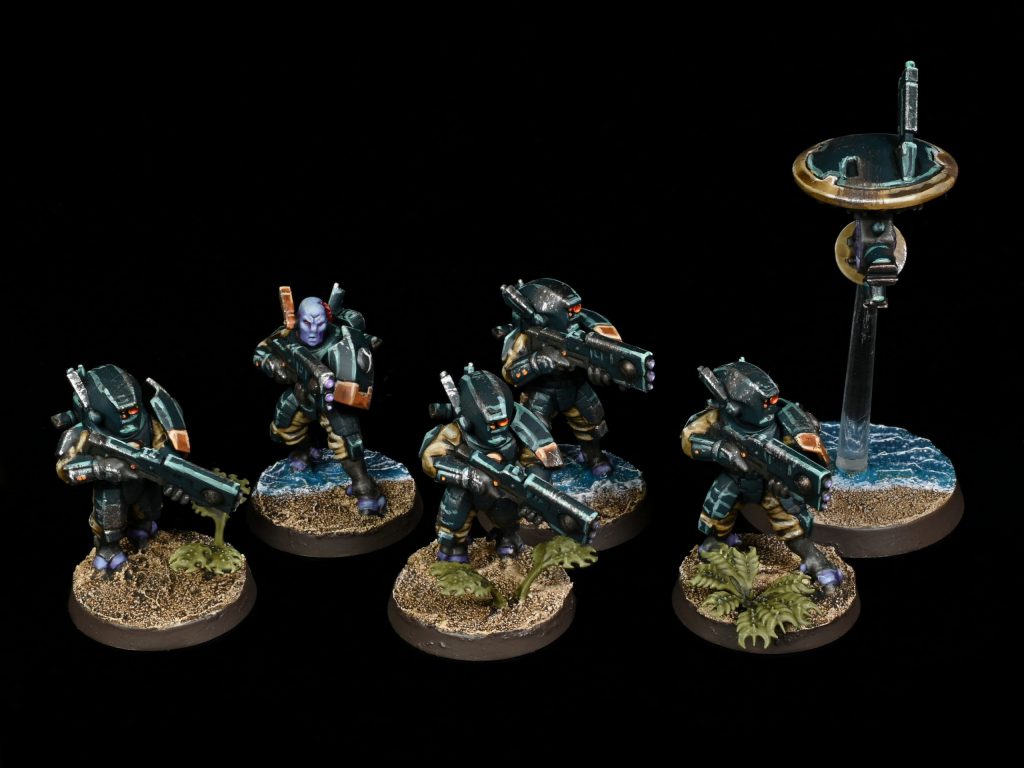
Tau Troops come in the form of two Fire Warrior flavours and Kroot, giving you the choice between “long-ranged shooting”, “short-ranged shooting” and “cheap & fast” as required. Of note in general – Fire Warrior teams now always come with exactly ten models, meaning you have a bit less flexibility in how you set them up.
That’s obviously bad news, but the good news is the price is pretty attractive (80pts for a Strike Team, 85pts for Breachers) and a combination of upgrades to their basic kit and the array of buffs you can apply makes them pretty dangerous. Strike Teams tote pulse rifles, one of the nastiest basic infantry guns in the game at RF1 36” S5 AP-1. As discussed in stratagems, you can easily push this as far as AP-3, can get two shots at full range, and can apply hit boosts or re-rolls in multiple ways, so these can hit with some reasonable force.
They’re obviously outclassed in that respect by Breachers, who are perfect for hurling out of a Devilfish right into the opponent’s face. The Pulse Blaster now only has two profiles, but they’re the good ones from the old loadout and mean that you start hitting hard at 14”, and can go full shotgun mode at 8”, easy to set up with Devilfish nonsense. With access to Breach and Clear they can do quite considerable damage to a wide range of targets, and just kind of rule all-round.
Both flavours of Fire Warriors have some shared upgrade options. They can take a turret that they can set up with an Action running from your Command Phase to your shooting phase, and gets packed up again if they move in future, which is cool and pretty elegantly implemented, but bluntly not something you ever want to blow points on, as you want these mobile. Much better is drones – the unit can take up to two of these, one of which can be a Guardian Drone. This applies a partial transhuman, preventing them being wounded on anything less than an unmodified 3+, helpful for grinding out a bit of extra survivability in a pinch. Adding one of these and a shield drone can make a pretty appreciable difference to their durability, and is very worth it if you have the points.
If you don’t have the points, buy Kroot. Thy die to a stiff breeze, but they’re very cheap at 60pts for 10, speedy and useful for covering early objective needs, and have picked up enough stat boosts that they can’t be totally ignored in combat. They’re great for filling third troop slot, and it seems plausible that if any Tau list wants to really carpet the table in bodies, this is where they’ll look.
Elites
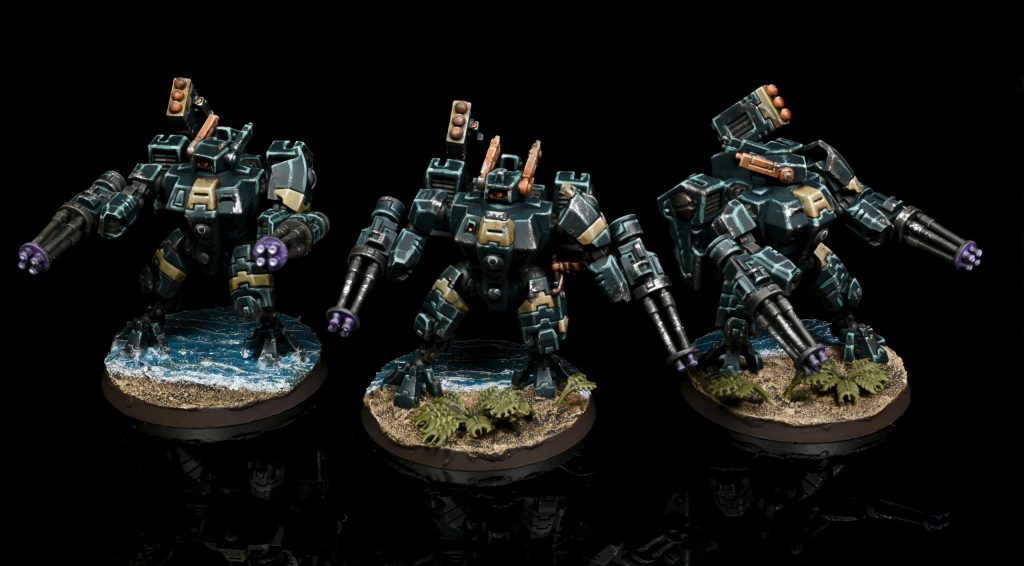
How else can we start but with Crisis Teams? Good news – they’re cool now. Faster (10”), tougher (4W and INFANTRY) and often cheaper, with all the improved guns we discussed earlier, packing a free support system hardpoint, and with a whole host of buffs you can apply to them, a unit of these feels worthwhile as an army centrepiece. It feels like a lot of the time one decently sized unit will be the play, as kitting up five can easily take you to around 300pts and you have lots of other stuff you want in your lists too, but that unit is going to be a serious power piece. There might be scope to go wider with some three-model units in some builds too, especially Farsight where a small squad coming in and blowing the strat can do some incredible damage. If you want to go all-in on a bomb unit then they can pack Drones too, and attaching a bunch of cheap gun drones to a squad as ablative wounds feels worth exploring too. This book in general feels like it was written by someone who cares about making Tau feel fun to use, and Crisis Teams are one of the places that really shines through – top marks.
Crisis Bodyguards have a reasonable amount of overlap with basic Crisis teams, but trade the free hardpoint for the Bodyguard rule, and can also be taken in two-model units if that’s somehow convenient to your list construction. Lacking the free hardpoint means that regular Crisis teams are your pick if you’re trying to construct an alpha unit, but a pair of these with a plasma rifle each seems like an OK use of 80pts if you have Characters you want to protect, especially as Tau Characters often absolutely want to be sitting in the open blasting away.
If you’re a fan of smaller battlesuits the Elite slot also has you covered, and here I want to hand over to Vrekais to talk about one of his vary favourite units.

Vrekais: Stealth suits remain one of the best units Tau have at their disposal. Whilst they have lost access to Shield Generators and other support systems. They gain a significant buff in cover, and their -1 to hit continues to function against ranged and melee attacks. Drones in the unit with them also have the cover bonus and -1 to hit making them an ideal place for some Marker Drones. They really come into their own when you start stacking the buffs on them though. It’s pretty easy to get 20+ S6 attacks out of a unit (see my notes on custom septs above) with AP-1,re-rolling 1s for wound rolls from Montka and with +1 to hit from marker lights. At that point, even at D1 you can do some significant damage and avoids being affected by the prevalent -1 damage abilities.
Pretty much that – stealth suits are super cheap for what they do, running you only 25pts per model at base now, and you can get value both from small units for screening and larger units you want to dump buffs on – 150pts for a full squad is just not that much. 5pts for adding one fusion blaster is a far more appealing choice these days too.
What if we made them bigger though? The Ghostkeel is an extra large Stealth Suit that brings some drone friends and some big guns. The key ability they have is the new version of their Stealth Drones, which mean they can only be targeted by enemies within 18” or if they’re the closest target. This makes one with a cyclic ion raker (which gained 12” of range this edition up to 36”) an interesting choice for a backfield objective holder – they can sit at a distance with relative impunity and a not inconsiderable amount of dakka, and even when they enemy starts going after them they get -1 to hit and can pack a Flare Launcher for an ignore wounds effect against high-S weapons. Having seen these in play in some of our test games, it honestly feels like these could probably have afforded to be given CORE – they’re just a tiny bit anemic, as the only buff that really works on them at the range they want to play is Markerlights, and they don’t get that much out of burning a token. One is fine, but you probably don’t want multiples.
Two more unusual options to close this section out – Krootox Riders and Firesight Marksmen. Krootox Riders don’t really have a niche – they’re kind of OK at a few different things, and are at least cheap enough that if they die instantly you’ll kind of shrug, but not something you’re rushing to add to a list. Firesights are more specialised, and something you add to a list with very specific plans in mind. Their 70pt price tag looks strange at first, but once you read their datasheet carefully you realise it’s because they come with three sniper drones. The Firesight packs a markerlight and can buff these drones up with the ability to ignore LoSir and hit for Mortals on 6s, and if they stay still then they cannot be shot unless they’re the closest eligible target or within 12”. That means that if they can see the opponent they’re really quite powerful – they add a markerlight and some decent discouragement to over-confident Characters. Gunum: He’s also the perfect man to carry Ohr’tu’s Lantern. The masses will tell you he’s a Marksmen, when really he’s just the spotter. The main issue is that you’re incredibly dependent on the terrain for how easy that is to achieve; we tried these out on some of the GW Open layouts and they were bad, just not getting any traction for most of the game. It’s possible that practice at positioning would help here, and on other layouts or player-placed terrain they could be a lot better, so definitely don’t write them off entirely.
Fast Attack
Very much a utility feel from the Tau Fast Attack slot, and standing out for that purpose are Pathfinders, for which I’ll once again hand over to Vrekais.
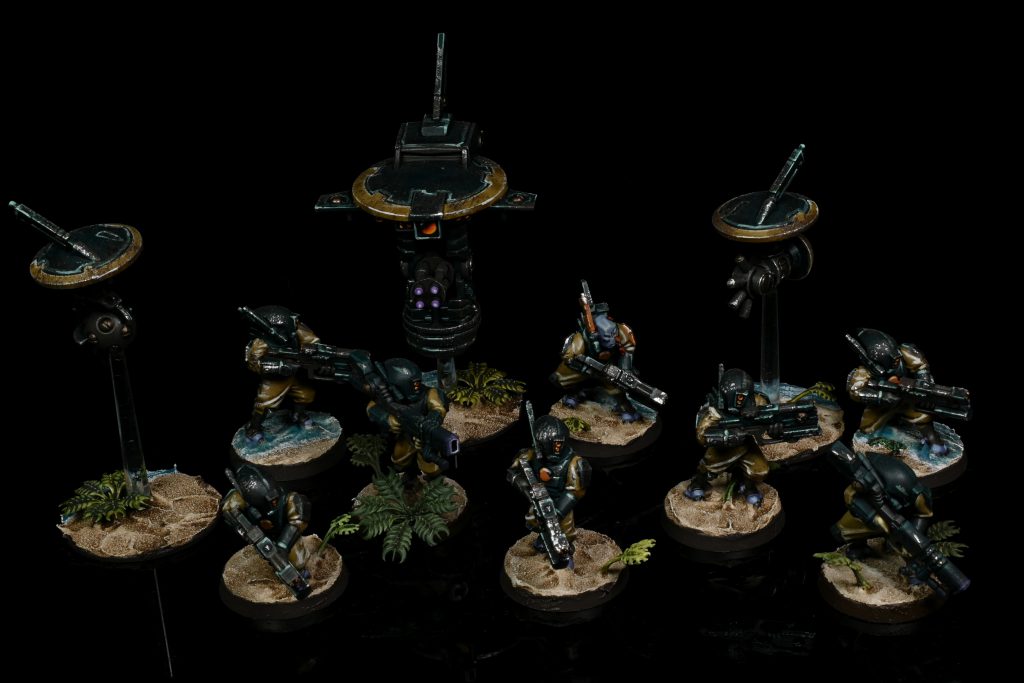
Vrekais: Pathfinders are back at the top of the Markerlight source list when considered in combination with the Recon Sweep stratagem. I’m a little disappointed they didn’t get some form of scout cover bonus, but being able to hop out of sight after marker lights are resolved is a big improvement in their staying power. It does however limit the usefulness of their other weapon options. Whilst Rail Rifles and Ion Rifles have reasonably strong profiles (and in Montka won’t need to worry too much about the Heavy Penalty) the unit will be best placed out of sight as often as possible, limiting their ability to actually shoot at anything. They have at least gotten significantly cheaper though at 5pts each, and no longer spending 20+ points to give a T3 5+ model a special weapon is very welcome.
Like Fire Warriors Pathfinders do now have to come in 10s, and this is the place that really hurts – if you could take fives you’d pack a unit in every single list, at 10 it’s something you have to plan around a bit more. They are good enough at their job that some armies will definitely want them – anyone spamming hulls or big suits needs lots of marker tokens to go around, and these are your guys for that. Being able to add three big rifles for only 15pts extra is honestly pretty interesting too – it gives you flexibility to go for the throat with them when the time is right. They’re also another unit with special drones – the Grav Inhibitor Drone, which provides a welcome penalty to enemies charging them, and the Pulse Accelerator Drone, which provides much-needed AP for their carbines, and the extra chunky Recon Drone, who is big and has a burst cannon, plus lets the whole unit ignore cover. Adding all the bonuses gives you a unit that isn’t cheap, but the flexibility to switch between Recon Sweep and going for markerlights and dakka is pretty cool.

Next up we have Piranhas – Pathfinders on mini-skimmers. These mostly function as dirt cheap ways to score the new version of Engage, being the least costly VEHICLE available to the army, and also give something you’re perfectly happy to sacrifice throwing onto an objective.The Greater Good calls.
Gunum: I think we would be remiss here to not mention that they have access to a new suped-up fusion gun and a very unique ability to come into your opponents DZ. This unit is more expensive then it was in the past, but it can provide a utility that it didn’t have before.
Also good in the cheap objective play category are Kroot Hounds, running you a mere 24pts for a squad of four who are fast enough (with their pre-game move) to tick off a distant quarter turn 1, and are the single cheapest unit you can put on the table to sit on a home objective, meaning they’re bound to see use.
If you want objective play with a big more crunch, Vespid are surprisingly pushed now, mostly because their guns are nasty at S5 AP-3 D2. Dealing damage isn’t their primary function, but you can throw a unit of six in your list for Retrieve Nachmund Data for a mere 72pts, and having some genuinely pretty relevant guns for a bit of chip damage on top of that is gravy. It’s just about possible that Dal’yth can push these to a point where they’re a credible threat, but just in general they’re an extremely acceptable utility squad.
Last up, Tactical Drones. If you want lots of gun, marker or shield drones you can take these in a separate unit of 4-12 models, and it seems plausible you sometimes might. Four marker drones is your easiest and cheapest way to put down some easy-to-use Markerlights, while in Farsight Enclaves dropping in some big Gun Drone units feels like it might have some play in Mont’ka – twelve of them is a whole lot of shots at only 96pts. Without Saviour Protocols Shield Drones aren’t that useful in their own right now, but if you’re on either of these other plans adding a few Shield Drones can provide some substantial extra tankiness. Definitely feels like there will be some uses for this datasheet overall.
Heavy Support
All killer, no filler here – four choices, and all of them with something to say.
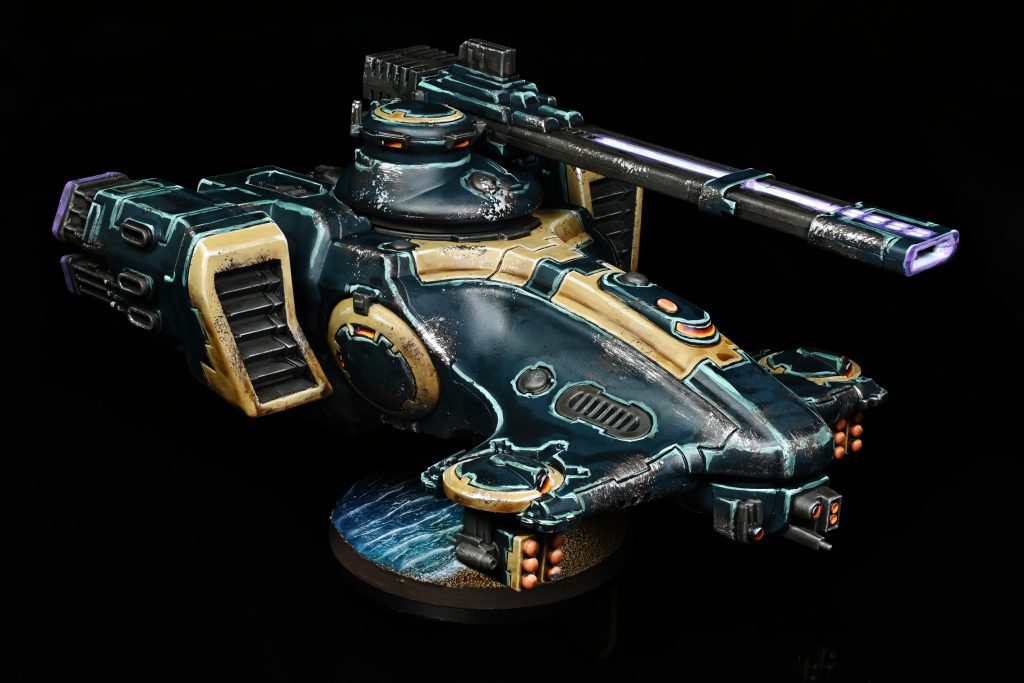
First up, the Hammerhead. The railgun is, in fact, one of the most hilariously over-the-top guns in the whole game, but is the whole package worth it? It’s certainly not bad – you only pay 145pts base for one of these, +10pts to upgrade your side guns from drones to either accelerator burst or SMS, which you’ll probably want, and that’s a pretty aggressive price tag. Based on that and the strength of the Sky Ray, there probably is a Tau build somewhere that wants to spam all of the hulls, but when building lists we have found, somewhat to our surprise, that Hammerheads are one of the things that’s easiest to cut. Having one in your list just for the sheer psychological pressure it creates does seem good (though in Tau Sept that should 100% be Longstrike), and running three is going to absolutely crush some opponents, but for all-comers lists you could find more flexible choices to be better.
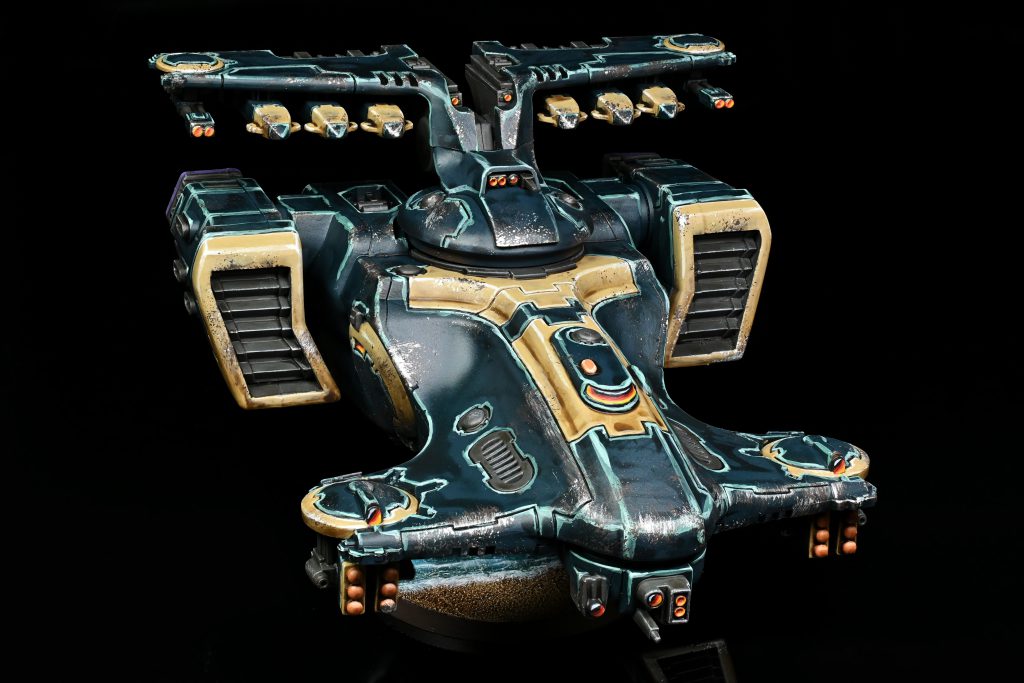
Flexible choices such as the Sky Ray, because oh boy. It’s 10pts cheaper than the Hammerhead, packs a pair of Markerlights (which as a VEHICLE it’s very good at deploying) and its missile rack is super good now, just giving you d3+1 seeker missile shots each turn, with a single hit re-roll from a Targeting Array like the Hammerhead. This is an incredible package overall – it’s still got big damage from its main gun with lower variance, Markerlights provide some valuable glue for the army, and because you’re likely to want to send it out hunting you can pack the spicy accelerator burst cannons on it and expect to do well out of them. In a book full of massively improved units this may well be the single biggest glow-up, so get hunting for the parts to knock the missile assemblies together ready to balance on top of your hulls. Expect to see lots of Tau players looking at both these and Hammerheads in their lists and weeping as they try to work out which to cut (which probably depends on how many really big targets are out there).
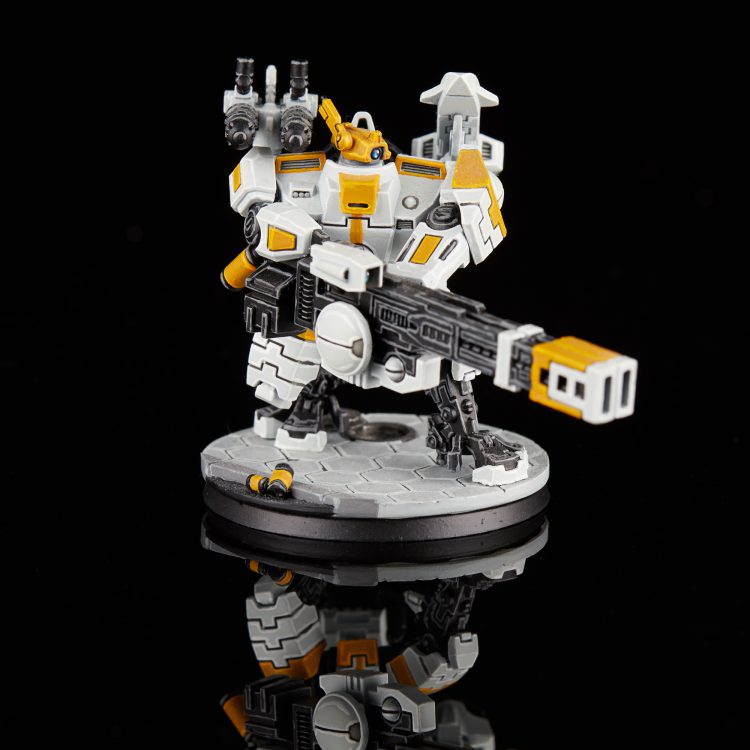
Broadsides are up next, and they also look pretty strong. The big draws out the gate here are that the rail rifle build is very cheap at 75pts before you start adding upgrades and side guns and as INFANTRY with a 2+ base save and a massive 8W they’re very tough to shift out of cover. They’re also the biggest CORE unit in the army, so a unit of three can be a great place to drop Shadowsun’s buff – if nothing else, 24 re-rolling SMS shots from out of sight is pretty scary, and now plasma rifles are good their alternative sidearm option of a twin plasma is actually worth consideration (particularly on solo models). They also get some unique suit systems – the ATS gives them auto-wounds on 6s to hit (again great if they’re planning to hide and use missiles till the enemy emerges) while the Enhanced Optics let them ignore penalties for moving and shooting, and also for shooting heavy weapons into combat. Which you want depends on how often you think you’re going to reliably be in Mont’ka while getting them into position – if you’re even the slightest bit unsure, probably take the Optics, if you’re dead certain you’re ride or die for Mont’ka, go for the ATS or one of the other choices. High-yield missile pods return as an option too, sporting baseline AP-2 in line with all other missile weapons, but they’re a considerable price premium over rail rifles and flat damage two, so definitely not the play competitively while damage reduction is such a big thing.
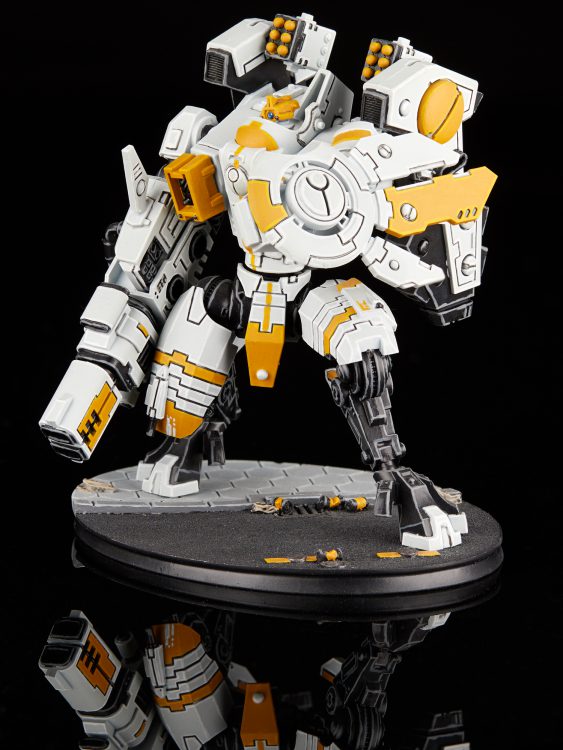
Last of all, migrated across from Elites, we have the iconic Riptide, the mobile suit of your dreams. These mostly do what they’ve always done – they’re a pretty potent mobile threat with some hefty guns and reasonable durability. That durability is pretty significantly improved from 8th – they now start on a 4+ invuln, and while the Nova Reactor can’t push that to a 3+ any more, it can apply a 5+ ignore wounds instead, which adds up to some serious resilience overall. The Nova Reactor in general has been re-vamped – rather than taking a wound to use it, when you try to activate it you have to roll under your current wounds on a 2d6,and if you fail it burns out for good (unless you save it with Branched Nova Charge). This means that at the start of the game it’s automatic and cost-free, allowing you to pick up your choice of the extra resilience, boosted shots (two extra for the Ion, four extra for the heavy burst) or an extra 2d6” move in the Charge Phase instead of Charging. All of these will be good in some situations, and the balance between the three feels well-pitched. Gun wise the decision is maybe a bit more skewed – right now you should pretty much always take the ion accelerator, as it’s a far scarier piece of kit, hitting at a hefty D4 if you overcharge it. Side-arms are a bit more up in the air – SMSs are never bad, but you could actually just take the (cheaper) plasma rifles and be pretty happy now, as they add further weight of high quality shooting. Rounding this datasheet out, the Shielded Missile Drones feel like a much more substantial consideration this time around, as though their shooting is kind of whatever, ablative wounds with an invuln feels handy. Riptides end up in an interesting spot overall – their datasheet is quite pushed, but there aren’t that many buffs that interact with them, so it’ll be interesting to see how they stack up against other options. If anyone is going to make triptides work again it’s probably the Farsight Enclaves – adding auto-Markerlights and a wound re-roll to the durable chassis here feels potent.
Gunum: They are also the cheapest they have ever been. Lets go, Robo!
Overall a very strong section – Skyrays kind of stand out for how much they do, but there’s a lot to like in all four datasheets, so big guns are very much on the menu.
Dedicated Transport
Just the one Dedicated Transport here, the stalwart Devilfish. You didn’t exactly see many of them in 8th edition, but they’ve had a decent upgrade in 9th, going up to 13 wounds and mounting an improved accelerator burst cannon. They’ve also gained the Armoured Aggression and Tactical Disengagement abilities, which make use of either Mont’ka or Kauyon respectively – if you picked Mont’ka, then Armoured Aggression lets you pre-game move the Devilfish up to 9”, while if you’re in Kauyon you can utilise Tactical Disengagement to remove the Devilfish at the end of your Movement phase and place it into Strategic Reserves, so long as it’s within 9” of a battlefield edge. That adds a lot of extra purpose to these, since you can use them to either push out early on or for redeploy tricks (and notably Tactical Disengagement can be used multiple times per game, which is an edge case but worthwhile to know). Objective grabbing has been a Tau weakness for all of 9th, and Devilfish now offer you a different angle on going out and getting them early game.
Lords of War
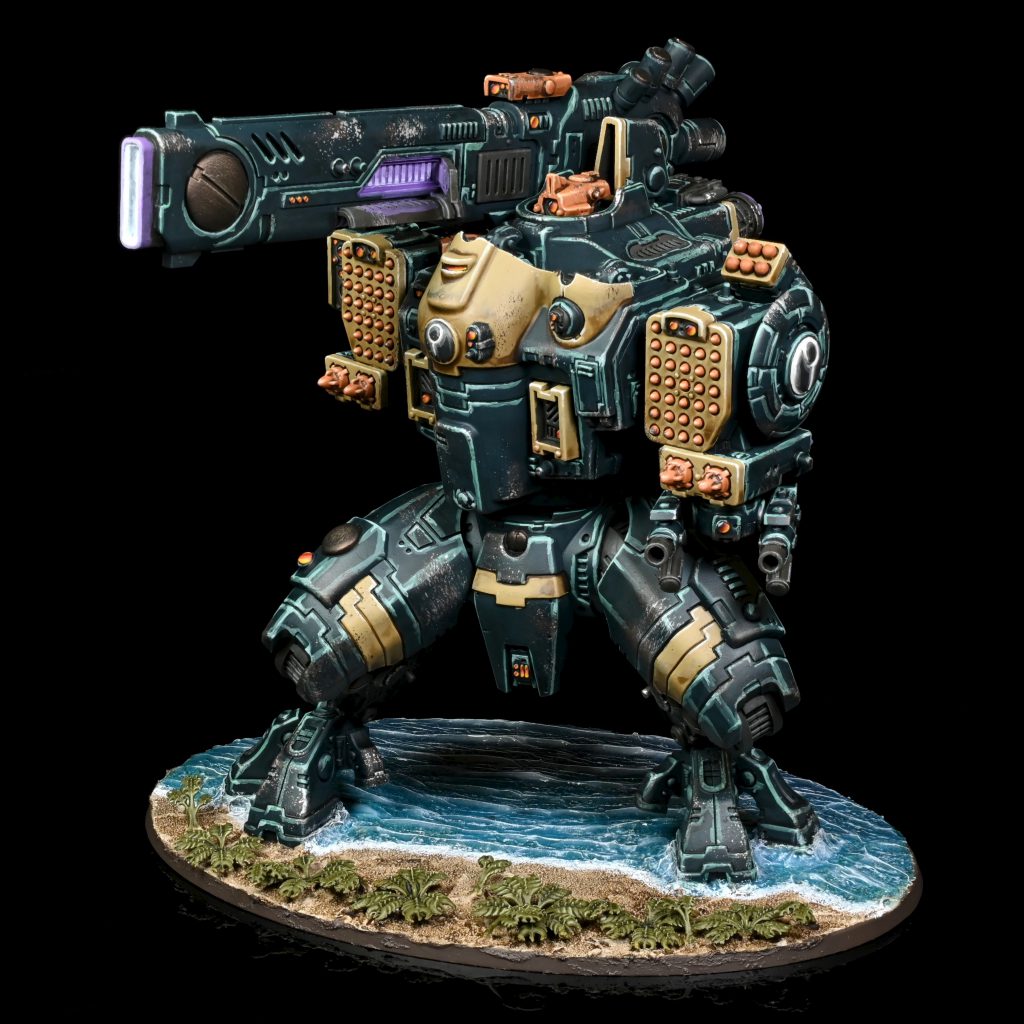
The Stormsurge is kind of fascinating because it looks wildly pushed but it’s not totally clear if it’s the best way to build towards mitigating the army’s weaknesses. The price tag isn’t low but it isn’t massive either – these top out at 345pts, and you get some serious stuff for that. The pulse blastcannon is definitely the marquee gun here, switching between six D4 shots or two colossal D12 shots, but the supporting cluster rocket system has gained AP like all other missiles, destroyer missiles are super seeker missiles at S12 AP-5 (capped at shooting two of your four per turn), and various sidearms benefit from the general gun uplift. It’s also nails, going up to T8 2+ with a 4+ base invulnerable save and 22 wounds, making it ultra hard to shift. Finally, its ability to deploy support anchors is very strong now, being an Action that runs from Command Phase to Shooting phase and granting full hit re-rolls – essentially therefore a bonus for remaining stationary.
Realistically, given the sheer power here, three of these in a list has got to be worth testing (sadly we didn’t get far enough through our matrix of planned lists to give them a go) – you can flip Mont’ka on and hustle them into firing positions, and you still have half a normal army to play with. Being T8 2+/4++ is also huge for them – you can’t hide them on most boards, but at that point there just isn’t much out there that kills you fast (though you do have to watch out for the Iron Hands super Contemptor), and you have shooting supremacy over most stuff. On paper that looks incredible, but the question will be whether a Tau army that’s burnt half its points here can ever win on objective play, especially on heavier boards – and I’m sure we’ll find out when people get these onto the table. Just throw a hundred and fifty Kroot down with them maybe. Also, gonna say – GW needs to take a long hard look at this datasheet and the Repulsor Executioner next to one another, and knock at least 80pts off the latter.
Flyer
Tau have two plastic flyers, the Razorshark Fighter and the Sun-shark bomber. Functionally here, only the Sun Shark is worth considering – it’s slightly more expensive, but is better in almost every possible way. Both Flyers are flimsy at only a 4+ with no invuln, but at least the Sun Shark is going to do some damage if it gets a turn – it gets twelve ion shots from its two Interceptor Drones, a hefty amount of D2 firepower when overcharges, gets “good” bombs similar to the AdMech Fusilave, adding more punishment, and even brings its own markerlight to set up for shooting. It will die instantly when the opponent hits back, so probably won’t recover its price tag, but it’s fine. The Razorshark is not fine – do not take one.
Fortifications
Tau get some weird fortifications in the various Tidewall pieces. The gimmick of these is that they can move, which is now modelled as them being open topped transports, and the stuff inside can perform an Action (lasting just from the start to end of the Movement Phase) to shuffle them 8”. It’s a relatively neat implementation, and coupled with the price tag on the cheaper pieces (80pts for a Shield Line or a Drone Port) means that it might, just about, be possible for these to see some fringe experimentation. These probably still don’t get there, but both have some mildly interesting applications. The Shield Line can have a full Strike Team embarked upon it, has a decent defensive profile including an invuln, and provides them with the ability to shoot into combat if the opponent charges them, and that’s maybe fine? Going in on the full Hear Me Out energy, you can also combo these with Pathfinders – complete your Markerlight Action, activate Recon Sweep to Normal Move onto the shieldwall then still blast away with your ion rifles. Is it the best thing you can do? Probably not – but it’s a cheap enough add-on that it’s not completely implausible either.
Gunum: I was going to talk about how cool I thought these were, then Wings stole my stchick. So I’ll just take you all on my Hear Me Out journey later, I guess.
The Drone Port is much less oblique in why it might be OK – you can stick three Crisis Suits on it and blast away Open Topped to your heart’s content. Here, to be honest, the risk of getting unlucky when it dies is probably enough to dissuade you, especially as the Droneport doesn’t get an invuln. The Gun Rig is also extremely whatever – but overall, it does feel just about possible that a single Shieldline turns out to be an interesting tech choice in some lists.
Our Thoughts
How They’ll Play
Tau favour two things – hitting the opponent fast and hard, and using synergies and combos to adapt their units for the situation at hand. Now that Devilfish are incredibly good they’re likely to be a staple – they’re a very effective tool for pushing for early objective control, do at least some appreciable chip damage if ignored, and have some built in flexibility based on your chosen Philosophy of War, helping you change up your plans early game if needed. They draw the enemy into battle, then your incredibly potent shooting kicks in to start doing some damage. The massive uplift to most guns mean Tau now have one of the best shooting phases in the game – as it should be for an army that’s still mostly skipping on the Fight Phase. You need to make judicious use of this firepower to secure yourself a position you can hold, ensuring that you don’t fall behind on Primary objectives (which is the biggest risk from having no melee). Suits being tougher and able to fire in combat helps with this – if your opponent tries to punk your Crisis team in melee and bounces off of a mixture of Sense of Stone and Saviour Protocols they’re suddenly in a world of hurt. Your powerful tanks also provide some much needed sturdiness, fast enough to start sweeping up the table if the opponent flags. Overseeing all of this, Commanders remain some of the best damage dealing characters in the game, uniquely excellent at shooting and now able to be built for melee as well. They will make their presence known whenever there are visible opponents, and give you an extra hammer blow you can use to turn the tide at a crucial moment. To succeed with Tau is going to mean using all your units effectively, and identifying and neutralising your opponents key counters, because a mediocre Fight Phase is still a big drawback – it’s just that now you get Movement and Shooting Phases good enough that smart play can push you through it.
Hot Takes
Wings
This time around, a lot of thoughts are going to be in the list section, because it’s fair to say that Vre’kais and Gunum are excited about this book and want to tell you all about their diabolical plans.
From my point of view, this Codex passes the crucial test for any 9th Edition book – it’s extremely clear that the writers wanted Tau to feel cool and understood how best to use their mechanics to accomplish that. This Codex looks like a total blast to play with – it’s loaded with cool options, the majority of the units feel like they’re good at their job and are aggressively priced, and the suite of mobility and defensive tools you have access to means you should be able to plan then execute some really exciting stuff on the table. I’ve been tinkering with some army lists while preparing this review and there are a lot of things I’d be excited to try out, and the internal balance seems good enough that there are very few clearly “wrong” choices. This aspect has grown on me over the course of the review, which is generally indicative of a good amount of depth – so very positive.
There are some things about it I’m less keen on – nothing that ruins the book, but still worth highlighting. Some of the mechanics feel maybe a bit more complicated than they need to, and variable cost guns are a bit of a headache for list building, and I expect to see lots of errors both on the tabletop and in army lists in the opening few weeks with this book. It’s nothing that familiarity won’t sort out, and I don’t see it as a long-term issue, but I wonder if maybe another pass to iron out complexity and a few weird interactions might have helped. My list of stuff from this book that I think is genuinely rules-ambiguous is longer than the one for Genestealer Cults, though to be fair can be construed more as praise for the GSC book than criticism for this one. I also think the internal balance of non-unit stuff here is a fair bit weaker than some other books – there are definite standout Septs, and the book contains the worst single relic yet published in 9th in the Kindled Blade. I’m also a little jumpy that triple Stormsurge might be strong, real, and not that much fun to deal with, but a lot of the worst excesses you can dream up with here get heavily mitigated by GW Open and UKTC terrain layouts.
None of those critiques stop me from calling this a success, and I think Tau players are going to be very happy with this book – it looks very fun to use, and like it plays in a way that properly aligns with the Tau’s fluff – always a winning combination.
Army Lists
Gunum:
Gunums 2000 Point Outer Enclaves
Farsight Enclave Allied Worlds Battalion Detachment
- Crisis Suit w/Iridum Battle Suit EWO, 2x Burst, 1x Fusion, Stimm Injector – 70
- Crisis Suit w/Iridum Battle Suit Counter Fire Defense, 2x Missile Pod, 1x Plasma – 65
- Crisis Suit w/Shield Gen 2 x Missile Pod, 1x Fusion – 70
- Crisis Suit w/Shield Gen 1x Fusion, 1x Plasma, 1x Missile Pod – 60
- Crisis Suit w/Shield Gen 2x Plasma, 1x Burst Cannon – 55
- Crisis Suit w/Shield Gen 2 Plasma 1x Fusion – 60
- Shield Drone x4 – 48
- Totals – Burst 3/ Fusion 4 /Missile Pod 5/ Plasma 6 (I promise, this count up was not intentional.)
- Crisis w/ Iridum Target Lock, 2x Cyclic, 1x Dominator Airburst – 65
- Crisis w/ Shield Gen 2x Flamer, 1x Fusion – 55
- Crisis w/ Shield Gen 2x Flamer, 1x Fusion – 55
- Shield Drone 1x, Marker Drone 1x – 22
- Totals – CiB 2/ Fusion 2/ Flamer 4
Wings: Gunum later told me to add a Seeker Missile to one of the Devilfish, but I have decided it’s funnier to leave it like this.
Gunum: I present to you a creation. A creation that I’ve been working on since the book arrived. Through playtesting, and a general exploration of the Tau Codex, I have landed on the list that you see before yourself.
Now, I play Farsight Enclaves very often. It is the way that I prefer to play Tau, one that is unafraid and is in your face covering you in a hot shooting death that presents a possible threat of dynamic entry. Like any good Farsight Enclave player, I have a very deep appreciation for battle suits. The thing that I don’t have a lot of appreciation for, is losing those treasured battle suits quickly against other multi damage armies. To fix that problem, I decided to start thinking out of the box and see the different things that this codex was able to provide me to help fix that problem. Enter, the Ethereal who gives out 5+ feel no pains like candy, while also fueling my war machine with command points. I plan on painting this guy with an eye patch, something akin to Snake from Escape from L.A, just to show off the brass balls he has with stealing Farsights moves.
The reliance on marker lights in Tau is hard to justify to me as a player, due to how easy it is to just kill off units like Pathfinders. The Enclaves trait was a requirement for any list that I would make moving forward purely because I can get use out of it for the entire game. You’ll notice that my Crisis teams are unique in the way that I built them, showcasing that the new book is encouraging them to have mixed weapons. I’ve invested in them because I expect these units to live, and I need them to live so I can deal with different problems.
From Crusher Stampede, to hordes of Wracks, to the rebellious new Genestealer cults book played by my local teammates, I need to have the right tools for every job. This is done by taking anti-tank in Fusion guns, anti-everything in Plasma and Missile Pods, and anti-horde in Burst cannons. These six suits are a unit designed to be living in the center of the table. I also have a second squad who will be starting in reserves, to harass the backfield. Bringing along their own anti-tank, but mostly focused on anti-infantry so that we can “Safely Evacuate” objectives of any infantry by causing them to run away.
Next, I have the Ghostkeel, his fan club of 10 gun drones, the Farsight marksman, and the Riptide all holding down my home front. Those units have a large enough footprint that I should be able to screen out my deployment zone very well. While the rest of my army pushes forward to challenge all of the center objectives. I also have brought Vespid to be a bit of an action-doing unit, which I would expect to see in the majority of Tau lists. A Riptide playing keep away behind a piece of obscuring terrain has been a strategy used by Tau players all 9th edition, and I don’t see that changing. The ion accelerator being increased to four damage only furthers the need to have something like this to pop open tanks or threaten some hammerheads (for example). Now that we have access to the 30-inch plasma guns, we can also hammer down on units that think they can stand out in the open and not be punished for it.
The Ghostkeel is a redemptor dreadnought that can’t be shot. With the new “can’t be targeted outside of 18”” buff, this finally makes a stealth unit feel like a stealth unit. “You can’t see me, but I can see you”, he declares as he rains death down the table.
I want to end on the unit that I think is most unique about my list (which does not mean they are good, I need to be clear here), which is the 10 gun drones that are babysitting that Ghostkeel. The gun drones will never leave the side of that Ghostkeel, for he is the carrier of the rare Drone Controller. I want to use these gun drones as a unique way to play area denial in my backfield. The 40 shots that hit on fours, are going to add up if someone decides to step out into the middle or wants to deep strike into my home area. If no one does decide to come into my beloved deployment zone, then, those 40 shots still should be able to target things that are trying to challenge the middle. This allows the drones to act as fire support for my crisis suits that are brawling there if needed.
I could talk about the devilfish and the Breachers, but I think those are self-explanatory by now. Devilfish got a huge buff, Breachers with shotguns are good and will continue to be good, and they are my primary ways to back up those crisis suits in the center of the table. I’m going to end on my commander. A Coldstar commander with four guns, and an exemplar of the Mont’ka, constantly buffing and a crisis suit team that moves 18 inches, is amazing. The shadow clone, otherwise known as the Hardlight projector, is a fantastic relic.
To back up a fantastic model. I built my commander with the same things in mind that I had with my crisis team. I wanted to pick a selection of weapons that can handle a lot of different problems, while at the same time making sure that it had a melee option so that it could either defend itself or be incredibly aggressive to help defend the crisis suits in the middle of the table. The secondaries for my list have been tough to decide on. I do think I’ll be looking at Engage, A Clean Victory and Nachmund Data. I may sub data out for Flags if I land on a 5 or 6 objective mission. A Clean Victory may be a bit of a gamble, but if I think I can guarantee the 12 points, I’ll take it. (Though to be 100%, if I have access to a better kill secondary, I’ma take that in a heartbeat.)
I’ve probably written too much about this subject, but I can’t get enough of this book. I have been having a blast playing with the new Codex and these great units. I hope you guys can see past the lies of the Farsight Enclaves and embrace the truth that is the Outer Enclaves.
Markerlights? 3. Crisis teams? 2. Ethereals? 1. F**ks? Zero. Let’s do this. Game on.
Vre’Kais
Calm Under Pressure and Reinforced Armour tenets, Battalion
HQ
Commander in XV8 Crisis Battlesuit x1 with Missile Pod x2 Plasma Rifle x1 Burst Cannon x1 Solid Image Projection Unit DW-02 Advanced Burst Cannon. Warlord – Precision of the Hunter – 150
Cadre Fireblade x1 with Fireblade Pulse Rifle x1 Markerlight, Puretide Engram Chip – 50, 1CP
Cadre Fireblade x1 with Fireblade Pulse Rifle x1 Markerlight – 50
Troops
Firewarrior Strike Team x10 – 80
Firewarrior Strike Team x10 – 80
Firewarrior Strike Team x10 – 80
Elites
XV8 Crisis Battlesuits x3 with Plasma Rifle x2 Missile Pod x1 Shield Generator – 180
– MV4 Shield Drone x5 – 60
XV25 Stealth Battlesuits x4 -100
– MV7 Marker Drone x2 – 20
XV25 Stealth Battlesuits x4 -100
– MV7 Marker Drone x2 – 20
XV25 Stealth Battlesuits x4 -100
– MV7 Marker Drone x2 – 20
Fast Attack
Pathfinder Team x10 – 90
Heavy Support
XV88 Broadside Battlesuits x3 with Heavy Rail Rifle x1 Twin Smart Missile System x1 Multi-Tracker – 270
– MV4 Shield Drone x5 – 60
Skyray, Smart Missile Systems – 145
Hammerhead, Accelerator Burst Cannons – 155
Dedicated Transport
Devilfish, gun drones – 95
Devilfish, gun drones – 95
2000pts, 11CP
Essentially this is a list of the models I like, arranged in the best way I can find to have a decent chance at being fun to play with if not win every game. It hits very hard with the +1 Strength within 12” for all my assault weapons, something Tau are not low on by any measure. The list’s resilience is based on a not insignificant number of shield drones for the Crisis and Broadside units, shield generators on Crisis also. In combination with Reinforced Armour this can make Battlesuits pretty difficult to shift. S6 isn’t too common, but reducing S5 to 5+ wound against my Crisis and Broadsides, as well as 4+ to wound vs my Stealth. S3 shooting will have a tough time wounding on 6+ vs most of the list. It also makes S7 anti tank guns struggle vs my Gunships, forcing the commitment of proper anti tank with S8 and above to really dent them efficiently.
I’ve opted to not bring any special weapons with my Pathfinders instead opting to use the stratagem to either jump back into a ruin or with their 7” movement phase move, and 7” Recon Sweep move cover enough of the board to end within Embarking range of Devilfish that has emptied itself that turn using Combat Debarkation.
The Fireblades and loaded Devilfish should allow me to move up to the flanks and use the Fireblades to set up some Aerial Targeting Relays, requiring both a unit of Devilfish and its Fire Warriors to be killed before they can shoot at the Fireblade nestled behind them from completing the action. This is a fine theory but I’ve still been struggling with the execution slightly.
Wings
Happily, that leaves me with the role of just slamming together something I think looks efficient and effective. I’ve generally gravitated towards either Tau Sept or Farsight Enclaves, so since we’ve already had the Outer Enclaves, let’s see what the Tau traditionalists can do.
Tau Sept Supreme Command
HQ
Shadowsun, high energy fusion, Warlord – 150
Tau Sept Battalion
HQ
Lonstrike, Smart missiles – 170
Aun’va, Sense of Stone, Zephyr’s Grace, Wisdom of the Guides – 80
Enforcer Commander, missile pod, cyclic ion blaster, flamer, plasma rifle, thermoneutronic projector, Be’gel Hunter’s Plate, Precision of the Hunter – 165, 1CP
Troops
Strike Team, Guardian Drone, Shield Drone – 102
Breacher Team, Guardian Drone, Shield Drone – 107
Breacher Team, Guardian Drone, Shield Drone – 107
Elites
Crisis Team – 250
- Shas’vre, Iridium Suit, 2 plasma rifles, missile pod, counterfire defence system, Stimm Injector – 70
- Shas’ui, 2 plasma rifles, missile pod, shield generator – 60
- Shas’ui, 2 plasma rifles, missile pod, shield generator – 60
- Shas’ui, 2 plasma rifles, missile pod, shield generator – 60
Stealth Team – 75
Fast Attack
Kroot Hounds – 24
Heavy Support
Skyray, accelerator burst cannons – 145
Skyray, accelerator burst cannons – 145
3 Broadsides, advanced targeting systems, twin sms – 270
Dedicated Transport
Devilfish, smart missile systems – 105
Devilfish, smart missile systems – 105
2000pts, 11CP
Hopefully if you’ve read my thoughts throughout the article this isn’t going to look too surprising – it’s got most of my faves. It can comfortably play in either Kauyon or Mont’ka, and has either the Devilfish or sacrificial Hounds or Stealth Suits to kick things off, then gets to work on blitzing the enemy down. The Crisis Team can play Strike and Fade games while blasting away until it’s time for them to move out, and dropping Shadowsun’s re-rolls on the Broadsides with their many SMS shots will punish an opponent that tries to hide. I’ve gone back and forth on ATS or enhanced optics on them and would want to try both, but at the moment I think the value of being able to grind down tougher targets from concealment wins out, especially as this list can add re-rolls, and mitigate hit penalties by handing them a free Markerlight with Longstrike.
Once the enemy is visible, well, the pain begins – Skyrays come out and start dropping markers and missiles, the Broadsides burst through a wall and blow something into tiny pieces, and Longstrike himself can commit if the opponent’s short on big guns, or something vital needs to become dead. From a strict optimisation point of view, right now the Stealth Suits should be a two-model Crisis Bodyguard team with minimal equipment just so Longstrike can act with impunity, but I like still being friends with people I play Warhammer against afterwards so that’s out. By all means do it in tournament lists, but don’t expect me to like it when I write it up in Competitive Innovations.
Rounding it out, we’ve got Commanders – Shadowsun who provides some nifty fusion shots, and the ultra-tanky Enforcer Commander build, who can pile on the pain at range and clear out a squad of Inteceptors or something in melee when needed. Both are good, and I think I’m quite a bit higher on Shadowsun than the rest of the team – having the targeting rule from the Advanced Guardian Drone makes her very flexible, and she’s a useful force multiplier for stuff that can hide like the Broadsides. She’s also pretty good for picking up a tick of Aerospace Targeting Relays.
I’d cheerfully pick this list up and take it to an event tomorrow – I’m sure it can be optimised, but it certainly reads as a fully functional force to me.
Wrap Up
So that’s Tau – it’s a hefty book that deserved a hefty review, and if you’re a fan of the Greater Good we hope you’re as excited as our team are. Make sure to come back for the Crusade review on Tuesday, and hit us up at contact@goonhammer.com if there’s anything you need to let us know about.
